Class 12 Amines NCERT Solutions FREE PDF Download
Amines class 12 NCERT solutions give deep insights into the chemistry of nitrogen-containing organic compounds, understanding their structures, properties, and reactions. With our FREE PDF download, access detailed explanations and practice questions, empowering you to grasp concepts effectively. From basic principles to advanced topics, NCERT Solutions for Class 12 Chemistry Amines provides valuable guidance, ensuring clarity in your studies. Enhance your understanding of Amines and excel in your academic journey with ease.
 Table of Content
Table of ContentDownload the FREE PDF of Class 12 NCERT Solutions for Amines prepared by master teachers. These NCERT Solutions are created according to the NCERT Syllabus for Class 12 Chemistry.
Quick Insights of Class 12 Amines NCERT Solutions
Class 12 Amines NCERT solutions will give you insights about the General Introduction: Nomenclature, classification, structure, methods of preparation, physical and chemical properties, and uses.
The section will give you crisp learnings on the identification of primary, secondary, and tertiary amines.
The understanding related to topics like Diazonium salts: Preparation, chemical reactions and importance in synthetic organic chemistry.
Using these Amines exercise Solutions can help students analyse their level of preparation and understanding of concepts.
NCERT solutions of Amines class 12 topics are included according to the revised syllabus for the academic year 2024-25.
Access NCERT Solutions Class 12 Chemistry Chapter 9 Amines
Intext Questions:
1. Classify the Following Amines as Primary, Secondary and Tertiary:
i.
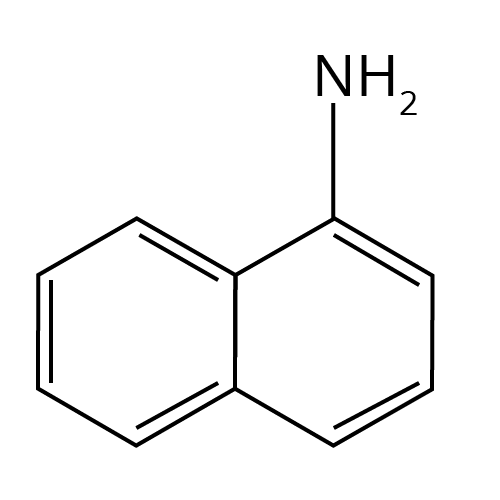
Ans: ${{1}^{0}}$
ii.
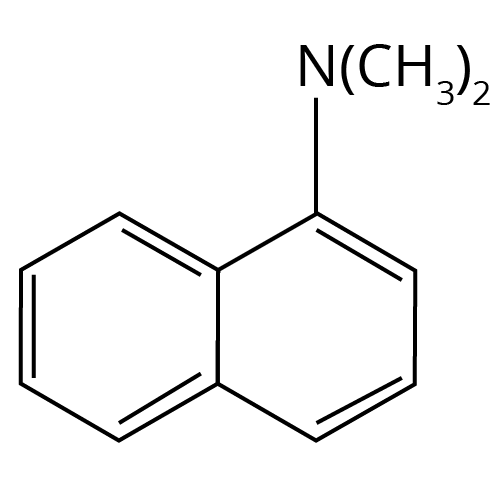
Ans: ${{3}^{0}}$
iii. \[{{({{C}_{2}}{{H}_{5}})}_{2}}CHN{{H}_{2}}\]
Ans: ${{1}^{0}}$
iv. ${{({{C}_{2}}{{H}_{5}})}_{2}}NH$
Ans: ${{2}^{0}}$
2.i. Write the structures of different isomers corresponding to the molecular formula, ${{C}_{4}}{{H}_{11}}N$ and write IUPAC names of all the isomers.
Ans: The structures and their IUPAC names of different isomeric amines corresponding to the molecular formula ${{C}_{4}}{{H}_{11}}N$ are given below:
a. $C{{H}_{3}}-C{{H}_{2}}-C{{H}_{2}}-C{{H}_{2}}-N{{H}_{2}}$ Butanamine (${{1}^{0}}$)
b. Butan-2-amine (${{1}^{0}}$)

c. 2-methyl propanamine (${{1}^{0}}$)

d. 2-methylpropan-2-amine (${{1}^{0}}$)

e. $C{{H}_{3}}-C{{H}_{2}}-C{{H}_{2}}-NH-C{{H}_{3}}$ N-ethylethanamine (${{2}^{0}}$)
f. $C{{H}_{3}}-C{{H}_{2}}-NH-C{{H}_{2}}-C{{H}_{3}}$ N- methylpropananmine (${{2}^{0}}$)
g. N-methylpropan-2-amine (${{2}^{0}}$)

h. N,N, Dimethylethanamine (${{3}^{0}}$ )

ii. What type of isomerism is exhibited by different pairs of amines?
Ans:
Position Isomers:
Butanamine (${{1}^{0}}$) and Butan-2-amine (${{1}^{0}}$);
N-ethylethanamine (${{2}^{0}}$) and N-methylpropan-2-amine (${{2}^{0}}$)
Chain Isomers:
Butanamine (${{1}^{0}}$) and 2-methyl propanamine (${{1}^{0}}$);
Butanamine (${{1}^{0}}$) and 2-methylpropan-2-amine (${{1}^{0}}$);
Butan-2-amine (${{1}^{0}}$) and 2-methyl propanamine (${{1}^{0}}$)
Butan-2-amine (${{1}^{0}}$) and 2-methylpropan-2-amine (${{1}^{0}}$)
Metamers:
N-ethylethanamine (${{2}^{0}}$) and N- methylpropananmine (${{2}^{0}}$)
N- methylpropananmine (${{2}^{0}}$) and N-methylpropan-2-amine (${{2}^{0}}$)
Functional Isomers: All ${{1}^{0}}$ amines are functional isomers of ${{2}^{0}}$ and ${{3}^{0}}$ amines and vice-versa
3. How Will You Convert,
a. Benzene into aniline
Ans:

b. Benzene into N,N- dimethylaniline
Ans:

c. $Cl-{{(C{{H}_{2}})}_{4}}-Cl$ into Hexane-1,6-diamine
Ans:
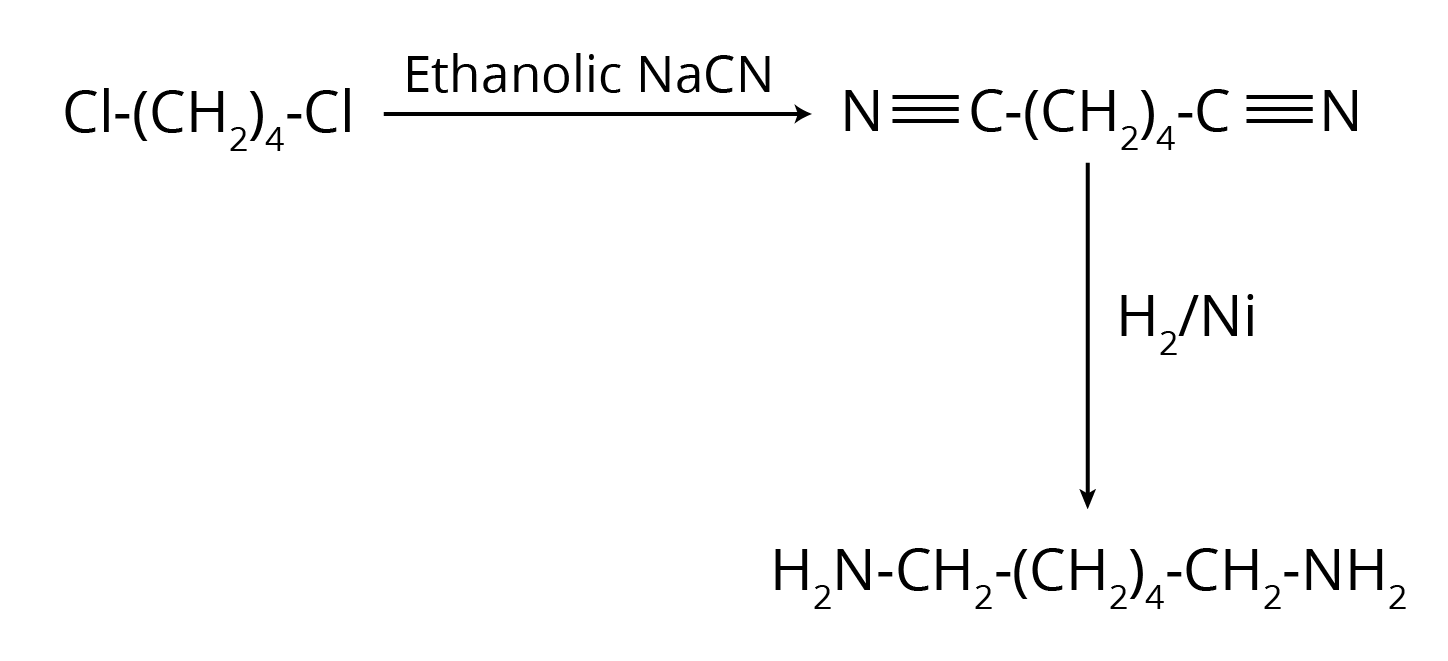
4. Arrange the following in increasing order of their basic strength:
i. ${{C}_{2}}{{H}_{5}}N{{H}_{2}},{{C}_{6}}{{H}_{5}}N{{H}_{2}},N{{H}_{3}},{{C}_{6}}{{H}_{5}}C{{H}_{2}}N{{H}_{2}}\And {{({{C}_{2}}{{H}_{5}})}_{2}}NH$
Ans: Considering the inductive effect of alkyl groups $N{{H}_{3}}$, ${{C}_{2}}{{H}_{5}}N{{H}_{2}}$ and ${{({{C}_{2}}{{H}_{5}})}_{2}}NH$ can be arranged in the increasing order of their basic strengths as:
\[N{{H}_{3}} < {{C}_{2}}{{H}_{5}}N{{H}_{2}} < {{({{C}_{2}}{{H}_{5}})}_{2}}NH\]
Again, ${{C}_{6}}{{H}_{5}}N{{H}_{2}}$has proton acceptability less than $N{{H}_{3}}$. Thus, we have:
\[{{C}_{6}}{{H}_{5}}N{{H}_{2}} < N{{H}_{3}} < {{C}_{2}}{{H}_{5}}N{{H}_{2}} < {{({{C}_{2}}{{H}_{5}})}_{2}}NH\]
Due to the −I effect of ${{C}_{6}}{{H}_{5}}-$ group, the electron density on the N-atom in ${{C}_{6}}{{H}_{5}}C{{H}_{2}}N{{H}_{2}}$ is lower than that on the N-atom in${{C}_{2}}{{H}_{5}}N{{H}_{2}}$, but more than that in $N{{H}_{3}}$. Therefore, the given compounds can be arranged in the order of their basic strengths as:
\[{{C}_{6}}{{H}_{5}}N{{H}_{2}} < N{{H}_{3}} < {{C}_{6}}{{H}_{5}}C{{H}_{2}}N{{H}_{2}} < {{C}_{2}}{{H}_{5}}N{{H}_{2}} < {{({{C}_{2}}{{H}_{5}})}_{2}}NH\]
ii. ${{C}_{2}}{{H}_{5}}N{{H}_{2}},{{({{C}_{2}}{{H}_{5}})}_{2}}NH,{{({{C}_{2}}{{H}_{5}})}_{3}}N,{{C}_{6}}{{H}_{5}}N{{H}_{2}},$
Ans: Considering the inductive effect and the steric hindrance of the alkyl groups, ${{C}_{2}}{{H}_{5}}N{{H}_{2}}$
${{({{C}_{2}}{{H}_{5}})}_{2}}NH$, and their basic strengths as follows:
\[{{C}_{2}}{{H}_{5}}N{{H}_{2}} < {{({{C}_{2}}{{H}_{5}})}_{3}}N < {{({{C}_{2}}{{H}_{5}})}_{2}}NH\]
Again, due to the −R effect of ${{C}_{6}}{{H}_{5}}-$ group, the electron density on the N atom in ${{C}_{6}}{{H}_{5}}N{{H}_{2}}$ is lower than that on the N atom in ${{C}_{2}}{{H}_{5}}N{{H}_{2}}$ . Therefore, the basicity of ${{C}_{6}}{{H}_{5}}N{{H}_{2}}$ is lower than that of ${{C}_{2}}{{H}_{5}}N{{H}_{2}}$. Hence, the given compounds can be arranged in the increasing order of their basic strengths as follows:
\[{{C}_{6}}{{H}_{5}}N{{H}_{2}} < {{C}_{2}}{{H}_{5}}N{{H}_{2}} < {{({{C}_{2}}{{H}_{5}})}_{3}}N < {{({{C}_{2}}{{H}_{5}})}_{2}}NH\]
iii. $C{{H}_{3}}N{{H}_{2}},{{(C{{H}_{3}})}_{2}}NH,{{(C{{H}_{3}})}_{3}}N,{{C}_{6}}{{H}_{5}}N{{H}_{2}},{{C}_{6}}{{H}_{5}}C{{H}_{2}}N{{H}_{2}}$
Ans: Considering the inductive effect and the steric hindrance of alkyl groups, $C{{H}_{3}}N{{H}_{2}}$ , ${{(C{{H}_{3}})}_{2}}NH$ , and ${{(C{{H}_{3}})}_{3}}N$ can be arranged in the increasing order of their basic strengths as:
\[{{(C{{H}_{3}})}_{3}}N < {{(C{{H}_{3}})}_{2}}NH < C{{H}_{3}}N{{H}_{2}}\]
In${{C}_{6}}{{H}_{5}}N{{H}_{2}}$ , N is directly attached to the benzene ring. Thus, the lone pair of electrons on the N−atom is delocalized over the benzene ring. In ${{C}_{6}}{{H}_{5}}C{{H}_{2}}N{{H}_{2}}$, N is not directly attached to the benzene ring. Thus, its lone pair is not delocalized over the benzene ring. Therefore, the electrons on the N atom are more easily available for protonation in ${{C}_{6}}{{H}_{5}}C{{H}_{2}}N{{H}_{2}}$ than in ${{C}_{6}}{{H}_{5}}N{{H}_{2}}$ i.e., ${{C}_{6}}{{H}_{5}}C{{H}_{2}}N{{H}_{2}}$ is more basic than ${{C}_{6}}{{H}_{5}}N{{H}_{2}}$. Again, due to the −I effect of ${{C}_{6}}{{H}_{5}}$ group, the electron density on the N−atom in ${{C}_{6}}{{H}_{5}}C{{H}_{2}}N{{H}_{2}}$ is lower than that on the N−atom in ${{(C{{H}_{3}})}_{3}}N$. Therefore, ${{(C{{H}_{3}})}_{3}}N$ is more basic than ${{C}_{6}}{{H}_{5}}C{{H}_{2}}N{{H}_{2}}$. Thus, the given compounds can be arranged in the increasing order of their basic strengths as follows.
\[{{C}_{6}}{{H}_{5}}N{{H}_{2}} < {{C}_{6}}{{H}_{5}}C{{H}_{2}}N{{H}_{2}} < {{(C{{H}_{3}})}_{3}}N<{{(C{{H}_{3}})}_{2}}NH < C{{H}_{3}}N{{H}_{2}}\]
5. Complete the following acid-base reactions and name the products:
i. $C{{H}_{3}}C{{H}_{2}}C{{H}_{2}}N{{H}_{2}}+HCl\to $
Ans:

ii. ${{({{C}_{2}}{{H}_{5}})}_{3}}N+HCl\to $
Ans:

6. Write reactions of the final alkylation product of aniline with excess of methyl iodide in the presence of sodium carbonate solution.
Ans: Aniline reacts with methyl iodide to produce N, N-dimethylaniline.
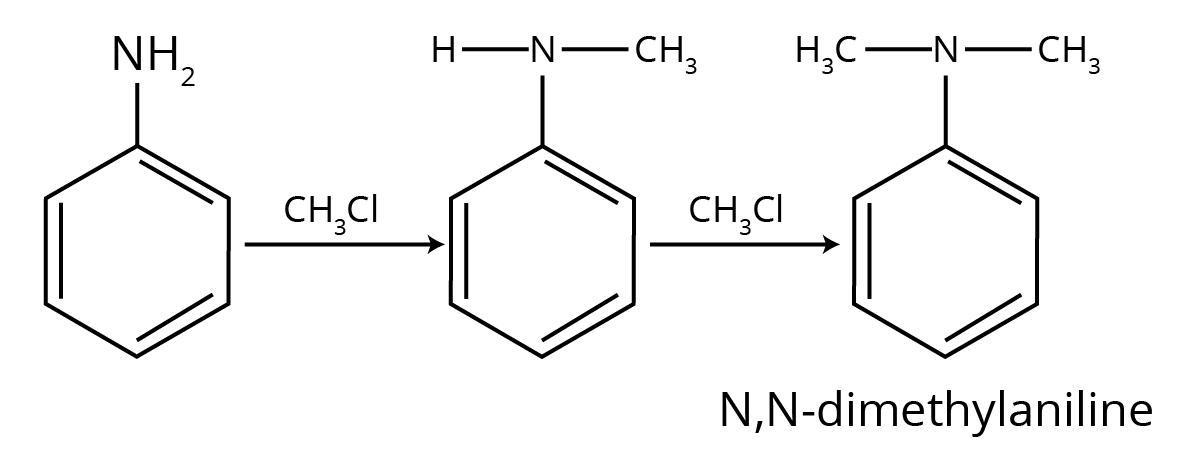
With excess methyl iodide, in the presence of $N{{a}_{2}}C{{O}_{3}}$ solution, N, N-dimethylaniline produces N, N, N−trimethylanilinium carbonate.

7. Write chemical reaction of aniline with benzoyl chloride and write the name of the product obtained.
Ans:
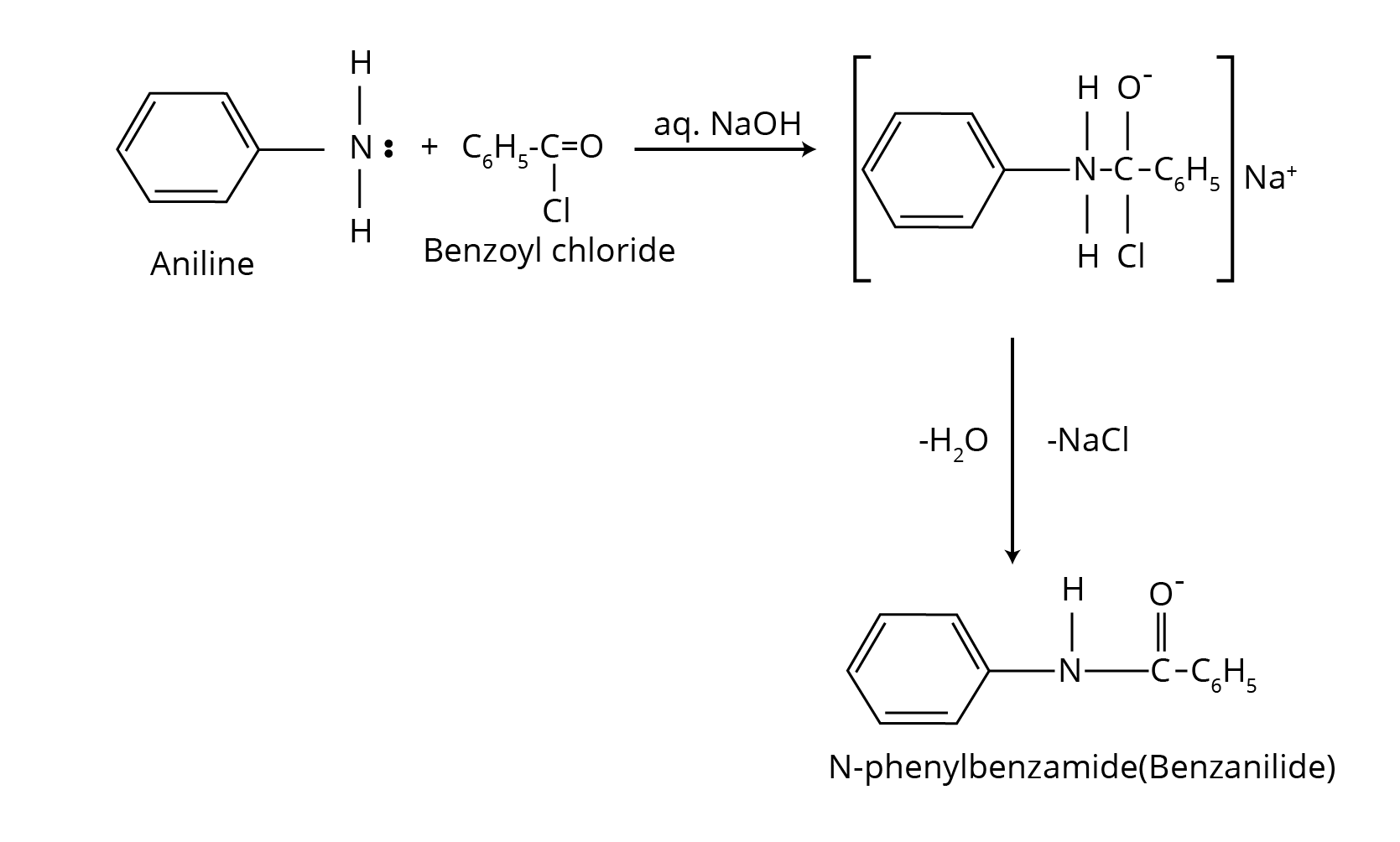
8. Write structures of different isomers corresponding to the molecular formula, ${{C}_{3}}{{H}_{9}}N$ . Write IUPAC names of the isomers which will liberate ${{N}_{2}}$ gas on treatment with nitrous acid.
Ans: In all, four structural isomers are possible. These are:
only ${{1}^{0}}$ amines react with $HN{{O}_{2}}$ to liberate ${{N}_{2}}$ gas
only ${{1}^{0}}$ amines react with $HN{{O}_{2}}$ to liberate ${{N}_{2}}$ gas
\[\underset{Propan-1-a\min e}{\mathop{C{{H}_{3}}C{{H}_{2}}C{{H}_{2}}N{{H}_{2}}}}\,+HN{{O}_{2}}\to \underset{Propan-1-ol}{\mathop{C{{H}_{3}}C{{H}_{2}}C{{H}_{2}}OH}}\,+{{N}_{2}}+{{H}_{2}}O\]

9. Convert:
i. 3-Methylaniline into 3-nitrotoluene
Ans:
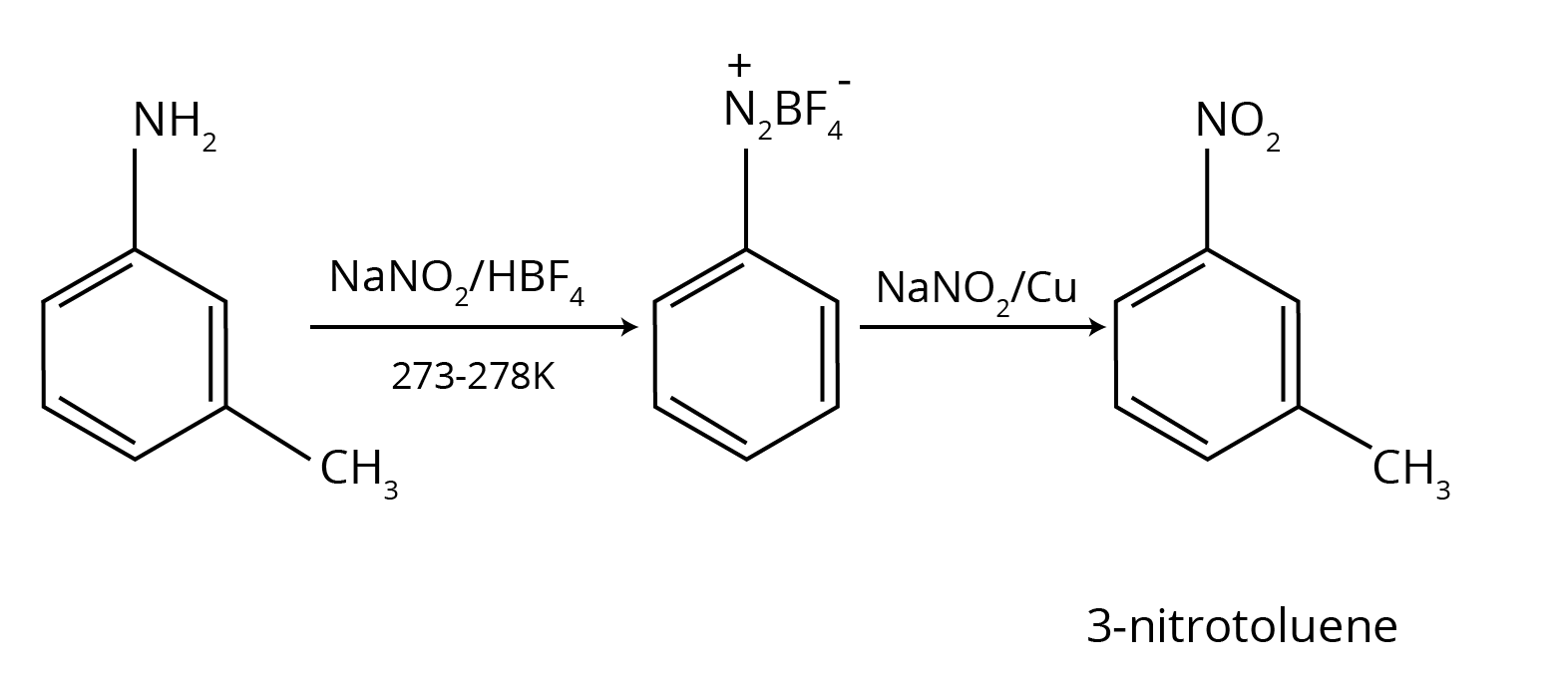
ii. Aniline into 1, 3, 5- Tribromo benzene
Ans:
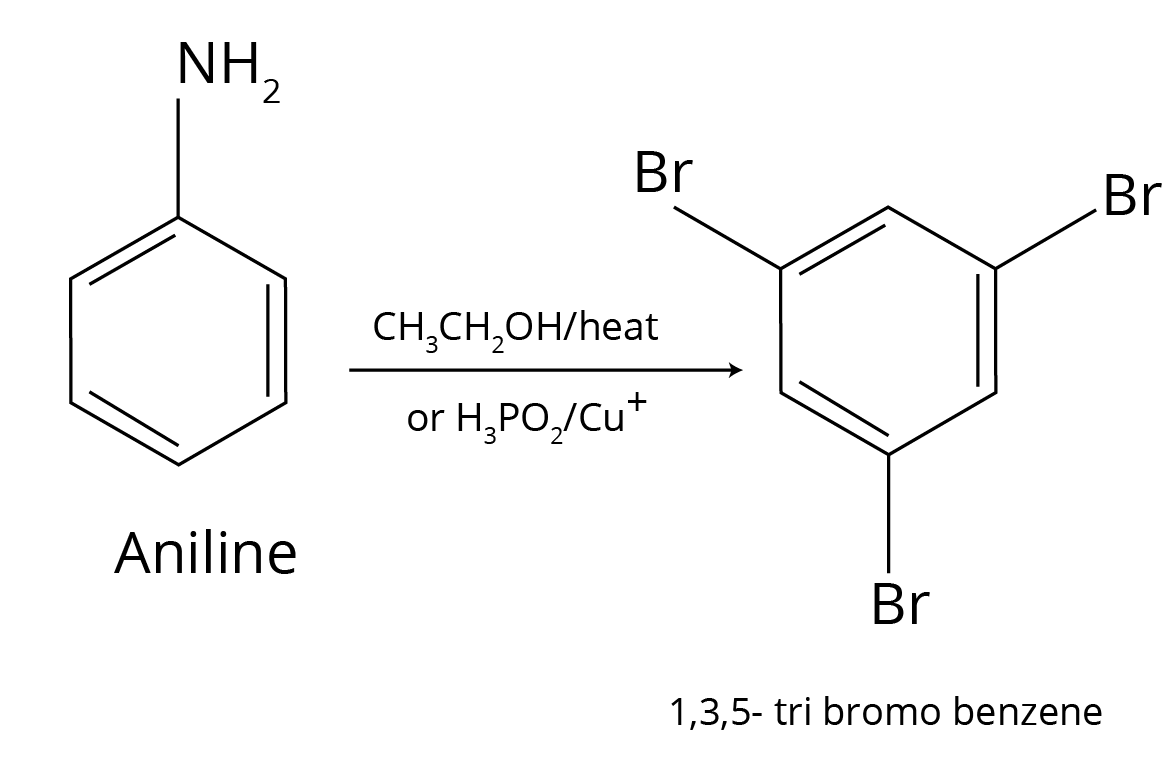
NCERT Exercises
1. Write IUPAC names of the following compounds and classify them into primary, secondary and tertiary amines.
a. ${{(C{{H}_{3}})}_{2}}CHN{{H}_{2}}$
Ans: 1-Methylethanamine (${{1}^{0}}$ amine)
b. $C{{H}_{3}}-{{(C{{H}_{2}})}_{2}}N{{H}_{2}}$
Ans: Propan-1-amine (${{1}^{0}}$amine)
c. $C{{H}_{3}}NHCH{{(C{{H}_{3}})}_{2}}$
Ans: N−Methyl-2-methylethanamine (${{2}^{0}}$ amine)
d. ${{(C{{H}_{3}})}_{3}}CNH$
Ans: 2-Methylpropan-2-amine (${{1}^{0}}$ amine)
e. ${{C}_{6}}{{H}_{5}}NHCH$
Ans: N−Methylbenzamine or N-methylaniline (${{2}^{0}}$ amine)
f. ${{(C{{H}_{3}}C{{H}_{2}})}_{2}}NC{{H}_{3}}$
Ans: N-Ethyl-N-methylethanamine (${{3}^{0}}$ amine)
g. $m-Br{{C}_{6}}{{H}_{4}}N{{H}_{2}}$
Ans: 3- bromobenzamine or 3- bromoaniline (${{1}^{0}}$ amine)
2. Give one chemical test to distinguish between the following pairs of compounds:
i. Methylamine and dimethylamine
Ans: Methylamine and methylamine can be distinguished by carbylamine test.
\[\underset{{}}{\mathop{C{{H}_{3}}N{{H}_{2}}}}\,+CHC{{l}_{3}}+3KOH\xrightarrow{\Delta }\underset{{}}{\mathop{C{{H}_{3}}NC}}\,+2KCl+3{{H}_{2}}O\]
\[{{(C{{H}_{3}})}_{2}}NH\xrightarrow{CHC{{l}_{3}}/KOH(alc)}\text{No reaction}\]
ii. Secondary and Tertiary Amines
Ans: Secondary and tertiary amine can be distinguished by Liebermann’s nitrosamine test. Secondary amines give Liebermann nitroamine tests while tertiary amines do not.
\[{{(C{{H}_{3}}C{{H}_{2}})}_{2}}NH+HO-N=O\xrightarrow{HCl+NaN{{O}_{2}}}\underset{\text{Yellow colour}}{\mathop{{{(C{{H}_{3}}C{{H}_{2}})}_{2}}N-N=O}}\,+{{H}_{2}}O\]
\[{{(C{{H}_{3}}C{{H}_{2}})}_{3}}N+HN{{O}_{2}}\to \underset{\text{Triethylammonium nitrate (soluble)}}{\mathop{[{{(C{{H}_{3}}C{{H}_{{{)}_{3}}}}NH]}^{+}}N{{O}_{2}}^{-}}}\,\]
iii. Ethylamine and Aniline
Ans: Ethylamine and aniline can be distinguished by azo test:
\[{{C}_{2}}{{H}_{5}}N{{H}_{2}}+HONO+HCl\xrightarrow{273-278K}{{C}_{2}}{{H}_{5}}OH+C{{H}_{2}}=C{{H}_{2}}+C{{H}_{3}}C{{H}_{2}}Cl+{{N}_{2}}\]
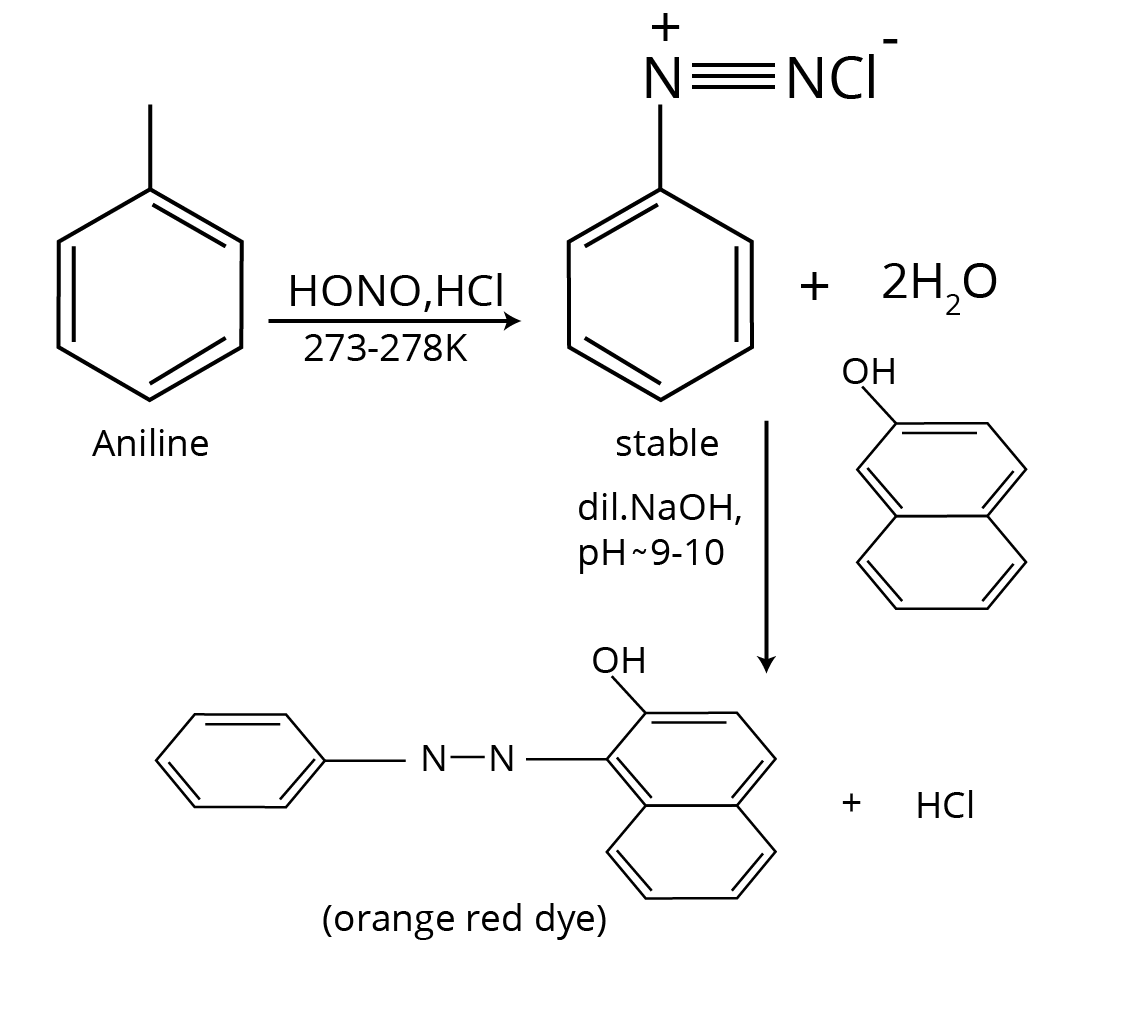
iv. Aniline and Benzylamine
Ans: Aniline and benzylamine can be distinguished by nitrous acid test:
\[{{C}_{6}}{{H}_{5}}C{{H}_{2}}N{{H}_{2}}\underset{HCl}{\mathop{\xrightarrow{HONO}}}\,[{{C}_{6}}{{H}_{5}}C{{H}_{2}}N_{2}^{+}C{{l}^{-}}]\xrightarrow[Decompose]{{{H}_{2}}O}{{C}_{6}}{{H}_{5}}C{{H}_{2}}OH+{{N}_{2}}\uparrow +HCl\]
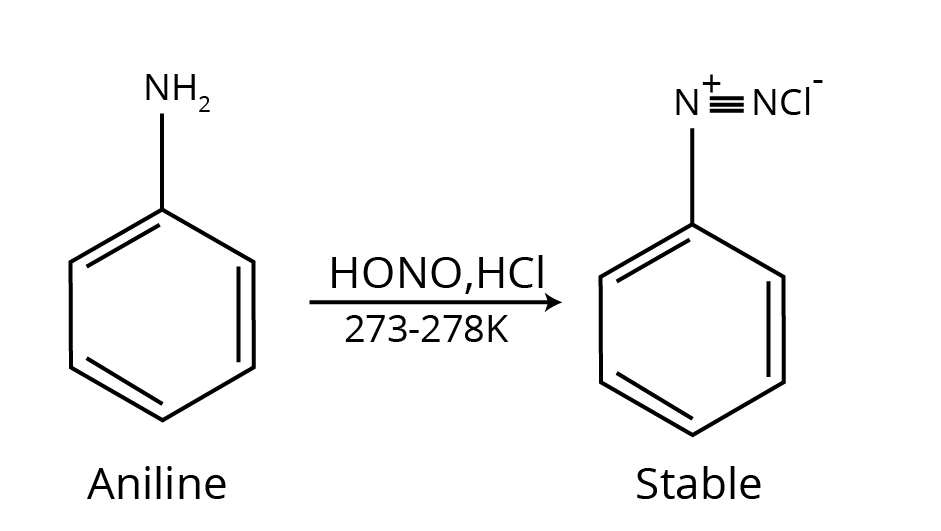
v. Aniline and N-Methylaniline.
Ans: Aniline and N-methylaniline can be distinguished by carbylamine test:
\[\underset{Aniline}{\mathop{{{C}_{6}}{{H}_{5}}N{{H}_{2}}}}\,+CHC{{l}_{3}}+3KOH\xrightarrow{\Delta }\underset{\text{Offensive smell}}{\mathop{{{C}_{6}}{{H}_{5}}NC}}\,+3KCl+3{{H}_{2}}O\]
\[{{C}_{6}}{{H}_{5}}-NH-C{{H}_{3}}\xrightarrow{CHC{{l}_{3}}+3KOH}\text{No reaction}\]
3. Account for the Following
a. ${{p}^{{{K}_{b}}}}$ of aniline is more than that of methylamine
Ans: In aniline, the lone pair of electrons on the N-atom is delocalized over the benzene ring. As a result, electron density on the nitrogen atom decreases. Whereas in $C{{H}_{3}}N{{H}_{2}}$ ,+ I-effect of $-C{{H}_{3}}$ group increases the electron density on the N-atom. Therefore, aniline is a weaker base than methylamine and hence its ${{p}^{{{K}_{b}}}}$ value is higher than that of methylamine.
b. Ethylamine is soluble in water whereas aniline is not.
Ans: Ethylamine dissolves in water due to intermolecular H-bonding. However, in case of aniline, due to the large hydrophobic part, i.e., hydrocarbon part, the extent of H-bonding is very less therefore aniline is insoluble in water.
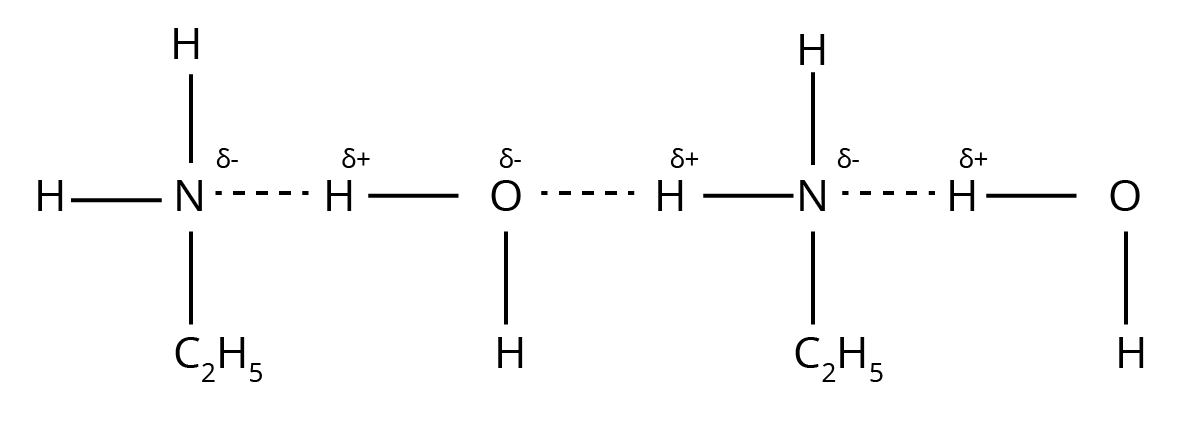
c. Methylamine in water reacts with ferric chloride to precipitate hydrated ferric oxide.
Ans: Methylamine being more basic than water, accepts a proton from water liberating $O{{H}^{-}}$ ions.

These $O{{H}^{-}}$ ions combine with $F{{e}^{+3}}$ ions present in ${{H}_{2}}O$ to form brown precipitate of hydrated ferric oxide.
\[FeC{{l}_{3}}\to F{{e}^{+3}}+3C{{l}^{-}}\]
\[2F{{e}^{+3}}+6OH\underset{\text{Brown ppt}}{\mathop{^{-}\to 2Fe{{(OH)}_{3}}orF{{e}_{2}}{{O}_{3}}.3{{H}_{2}}O}}\,\]
d. Although amino group is o and p — directing in aromatic electrophilic substitution reactions, aniline on nitration gives a substantial amount of m-nitroaniline.
Ans: Nitration is usually carried out with a mixture of conc $HN{{O}_{3}}$ + conc ${{H}_{2}}S{{O}_{4}}$ . In presence of these acids, most of aniline gets protonated to form anilinium ion. Therefore, in the presence of acids, the reaction mixture consists of aniline and anilinium ion. Now, $-N{{H}_{2}}$ group in aniline is activating and o, p-directing while the $N{{H}_{3}}^{+}$ group in anilinium ion is deactivating and m-directing: Nitration of aniline (due to steric hindrance at o-position) mainly gives p-nitroaniline, the nitration of anilinium ion gives m-nitroaniline. In actual practice, approx a 1:1 mixture of p-nitroaniline and m-nitroaniline is obtained. Thus, nitration of aniline gives a substantial amount of m-nitroaniline due to protonation of the amino group.
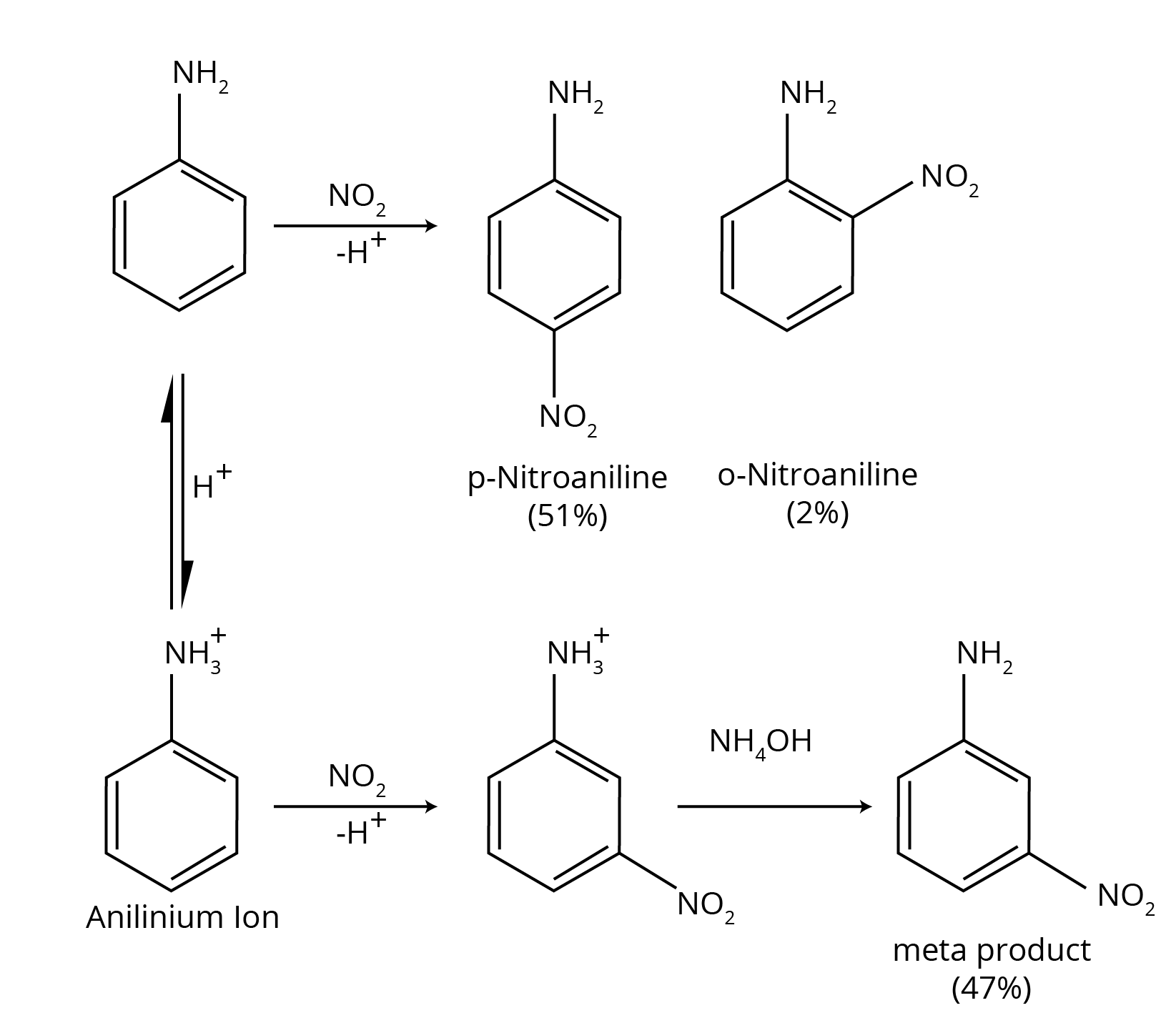
e. Aniline does not undergo Friedel-Crafts reaction.
Ans: Aniline being a Lewis base reacts with Lewis acid $AlC{{l}_{3}}$ to form a salt.
\[{{C}_{6}}{{H}_{5}}N{{H}_{2}}+AlC{{l}_{3}}\to {{C}_{6}}{{H}_{5}}N{{H}_{2}}^{+}AlC{{l}_{3}}^{-}\]
As a result, N of aniline acquires positive charge and hence it acts as a strong deactivating group for electrophilic substitution reactions. Consequently, aniline does not undergo Friedel Crafts reaction.
f. Diazonium salts of aromatic amines are more stable than those of aliphatic amines.
Ans: The diazonium salts of aromatic amines are more stable than those of aliphatic amines due to dispersal of the positive charge on benzene ring as a result of resonance

g. Gabriel phthalimide synthesis is preferred for synthesizing primary amines.
Ans: Gabriel phthalimide reaction gives pure primary amines without any contamination of secondary and tertiary amines. Therefore, it is preferred for synthesizing primary amines.
4. Arrange the Following.
i. In Decreasing Order of ${{p}^{{{K}_{b}}}}$Values:
\[{{C}_{6}}{{H}_{5}}N{{H}_{2}},{{C}_{6}}{{H}_{5}}NHC{{H}_{3}},{{({{C}_{2}}{{H}_{5}})}_{2}}NH\And {{C}_{2}}{{H}_{5}}N{{H}_{2}}\]
Ans: In ${{C}_{2}}{{H}_{5}}N{{H}_{2}}$ , only one $-{{C}_{2}}{{H}_{5}}$ group is present while in ${{({{C}_{2}}{{H}_{5}})}_{2}}NH$, two $-{{C}_{2}}{{H}_{5}}$ groups are present. Thus, the +I effect is more in ${{({{C}_{2}}{{H}_{5}})}_{2}}NH$ than in ${{C}_{2}}{{H}_{5}}N{{H}_{2}}$. Therefore, the electron density over the N-atom is more in ${{({{C}_{2}}{{H}_{5}})}_{2}}NH$ than in ${{C}_{2}}{{H}_{5}}N{{H}_{2}}$. Hence, ${{({{C}_{2}}{{H}_{5}})}_{2}}NH$ is more basic than ${{C}_{2}}{{H}_{5}}N{{H}_{2}}$. Also, both ${{C}_{6}}{{H}_{5}}NHC{{H}_{3}}$ and ${{C}_{6}}{{H}_{5}}N{{H}_{2}}$ are less basic than ${{({{C}_{2}}{{H}_{5}})}_{2}}NH$ and ${{C}_{2}}{{H}_{5}}N{{H}_{2}}$ due to the delocalization of the lone pair in the former two. Further, among ${{C}_{6}}{{H}_{5}}NHC{{H}_{3}}$ and${{C}_{6}}{{H}_{5}}N{{H}_{2}}$ , the former will be more basic due to the +I effect of $-C{{H}_{3}}$ group. Hence, the order of increasing basicity of the given compounds is as follows:
\[{{C}_{6}}{{H}_{5}}N{{H}_{2}} < {{C}_{6}}{{H}_{5}}NHC{{H}_{3}} < {{C}_{2}}{{H}_{5}}N{{H}_{2}} < {{({{C}_{2}}{{H}_{5}})}_{2}}NH\]
We know that the higher the basic strength, the lower is the ${{p}^{{{K}_{b}}}}$ values
\[{{C}_{6}}{{H}_{5}}N{{H}_{2}} > {{C}_{6}}{{H}_{5}}NHC{{H}_{3}} > {{C}_{2}}{{H}_{5}}N{{H}_{2}} > {{({{C}_{2}}{{H}_{5}})}_{2}}NH\]
ii. In Increasing Order of Basic Strength
\[{{C}_{6}}{{H}_{5}}N{{H}_{2}},{{C}_{6}}{{H}_{5}}N{{(C{{H}_{3}})}_{2}},{{({{C}_{2}}{{H}_{5}})}_{2}}NH\And C{{H}_{3}}N{{H}_{2}}\]
Ans: Among $C{{H}_{3}}N{{H}_{2}}$ and ${{({{C}_{2}}{{H}_{5}})}_{2}}NH$, primarily due to the greater +I-effect of the two $-{{C}_{2}}{{H}_{5}}$ groups over one $-C{{H}_{3}}$ group, ${{({{C}_{2}}{{H}_{5}})}_{2}}NH$ is more basic than $C{{H}_{3}}N{{H}_{2}}$. In both ${{C}_{6}}{{H}_{5}}N{{H}_{2}}$ and ${{C}_{6}}{{H}_{5}}N{{(C{{H}_{3}})}_{2}}$ lone pair of electrons present on N-atom is delocalized over the benzene ring but ${{C}_{6}}{{H}_{5}}N{{(C{{H}_{3}})}_{2}}$is more basic due to +I effect of two $-C{{H}_{3}}$groups.
\[{{({{C}_{2}}{{H}_{5}})}_{2}}NH > C{{H}_{3}}N{{H}_{2}} > {{C}_{6}}{{H}_{5}}N{{(C{{H}_{3}})}_{2}} > {{C}_{6}}{{H}_{5}}N{{H}_{2}}\]
Decreasing basic strength
iii. In Increasing Order of Basic Strength
(a) Aniline, P-Nitroaniline and P-Toluidine
Ans: The presence of electron donating $-C{{H}_{3}}$group increases while the presence of electron withdrawing $N{{O}_{2}}$ group decreases the basic strength of amines.
\[\therefore p-nitroaniline < \text{ }aniline\text{ } < \text{ }p-toluidine\]
Increasing basic strength
(b) \[{{C}_{6}}{{H}_{5}}N{{H}_{2}},{{C}_{6}}{{H}_{5}}NHC{{H}_{3}},{{C}_{6}}{{H}_{5}}C{{H}_{2}}N{{H}_{2}}\]
Ans: In ${{C}_{6}}{{H}_{5}}N{{H}_{2}}$ and ${{C}_{6}}{{H}_{5}}NHC{{H}_{3}}$, Nitrogen is directly attached to the benzene ring. As a result, the lone pair of electrons on the N-atom is delocalized over the benzene ring. Therefore, both ${{C}_{6}}{{H}_{5}}N{{H}_{2}}$ and ${{C}_{6}}{{H}_{5}}NHC{{H}_{3}}$ are weaker base in comparison to ${{C}_{6}}{{H}_{5}}C{{H}_{2}}N{{H}_{2}}$. Among ${{C}_{6}}{{H}_{5}}N{{H}_{2}}$ and ${{C}_{6}}{{H}_{5}}NHC{{H}_{3}}$, due to +1 effect of $-C{{H}_{3}}$group ${{C}_{6}}{{H}_{5}}NHC{{H}_{3}}$ is more basic.
\[{{C}_{6}}{{H}_{5}}N{{H}_{2}} < {{C}_{6}}{{H}_{5}}NHC{{H}_{3}} < {{C}_{6}}{{H}_{5}}C{{H}_{2}}N{{H}_{2}}\]
Increasing basic strength
iv. In Decreasing Order of Basic Strength in Gas Phase
\[{{C}_{2}}{{H}_{5}}N{{H}_{2}},{{({{C}_{2}}{{H}_{5}})}_{2}}NH,{{({{C}_{2}}{{H}_{5}})}_{3}}N\And N{{H}_{3}}\]
Ans: In gas phase or in non-aqueous solvents such as chlorobenzene etc, the solvation effects
i. e. the stabilization of the conjugate acid due to H-bonding is absent. Therefore, basic strength depends only upon the +I-effect of the alkyl groups. The +I-effect increases with increase in the number of alkyl groups. Thus, correct order of decreasing basic strength in gas phase is,
\[\therefore {{({{C}_{2}}{{H}_{5}})}_{3}}N > {{({{C}_{2}}{{H}_{5}})}_{2}}N > {{C}_{2}}{{H}_{5}}N{{H}_{2}} > N{{H}_{3}}\]
Decreasing basic strength
v. In Increasing Order of Boiling Point
\[{{C}_{2}}{{H}_{5}}OH,(C{{H}_{3}})NH,{{C}_{2}}{{H}_{5}}N{{H}_{2}}\]
Ans: Since the electronegativity of Oxygen is higher than that of Nitrogen, therefore, alcohols form stronger H-bonds than amines. Also, the extent of H-bonding depends upon the number of H-atoms on the N-atom, thus the extent of H-bonding is greater in primary amine than secondary amine.
\[{{(C{{H}_{3}})}_{2}}N{{H}_{2}} < {{C}_{2}}{{H}_{5}}N{{H}_{2}} < {{C}_{2}}{{H}_{5}}OH\]
Increasing boiling point
vi. In Increasing Order of Solubility in Water
\[{{C}_{6}}{{H}_{5}}N{{H}_{2}},{{({{C}_{5}}{{H}_{5}})}_{2}}NH,{{C}_{2}}{{H}_{5}}N{{H}_{2}}\]
Ans: Solubility decreases with increase in molecular mass of amines due to increase in the size of the hydrophobic hydrocarbon part and with decrease in the number of H-atoms on the N-atom which undergo H-bonding.
\[{{C}_{6}}{{H}_{5}}N{{H}_{2}} < {{({{C}_{6}}{{H}_{5}})}_{2}}NH < {{C}_{2}}{{H}_{5}}N{{H}_{2}}\]
Increasing solubility
5. How Will You Convert?
i. Ethanoic Acid into Methanamine
Ans:
\[C{{H}_{3}}COOH\xrightarrow[-S{{O}_{2}},-HCl]{SOC{{l}_{2}}}C{{H}_{3}}COCl\xrightarrow[N{{H}_{4}}Cl]{N{{H}_{3}}(excess)}C{{H}_{3}}CON{{H}_{2}}\xrightarrow[{}]{B{{r}_{2}}/NaOH}C{{H}_{3}}N{{H}_{2}}\]
ii. Hexanenitrile into 1-Aminopentane.
Ans:
\[C{{H}_{3}}{{(C{{H}_{2}})}_{4}}CN\xrightarrow{{{H}_{3}}{{O}^{+}}}C{{H}_{3}}{{(C{{H}_{2}})}_{4}}COOH\xrightarrow[-S{{O}_{2}},-HCl]{SOC{{l}_{2}}}C{{H}_{3}}{{(C{{H}_{2}})}_{4}}COCl\xrightarrow[-N{{H}_{4}}Cl]{N{{H}_{3}}(excess)}C{{H}_{3}}{{(C{{H}_{2}})}_{4}}CON{{H}_{2}}\xrightarrow[{}]{B{{r}_{2}}/NaOH}C{{H}_{3}}{{(C{{H}_{2}})}_{4}}N{{H}_{2}}\]
iii. Methanol to Ethanoic Acid.
Ans:
\[C{{H}_{3}}OH\xrightarrow[-POC{{l}_{5}}]{PC{{l}_{5}}}C{{H}_{3}}Cl\xrightarrow{KCN(alc)}C{{H}_{3}}CN\xrightarrow{{{H}_{3}}{{O}^{+}}}C{{H}_{3}}COOH\]
iv. Ethanamine into Methanamine
Ans:
\[C{{H}_{3}}C{{H}_{2}}N{{H}_{2}}\xrightarrow[-{{N}_{2}},-{{H}_{2}}O]{HONO}C{{H}_{3}}C{{H}_{2}}OH\xrightarrow[{}]{{{K}_{2}}C{{r}_{2}}{{O}_{7}}/{{H}_{2}}S{{O}_{4}}}C{{H}_{3}}CHO\xrightarrow{{{K}_{2}}C{{r}_{2}}{{O}_{7}}/{{H}_{2}}S{{O}_{4}}}C{{H}_{3}}COOH\]
\[C{{H}_{3}}COOH\xrightarrow{N{{H}_{3}}}C{{H}_{3}}COON{{H}_{4}}\xrightarrow[-{{H}_{2}}O]{}C{{H}_{3}}CON{{H}_{2}}\xrightarrow{B{{r}_{2}}/NaOH}C{{H}_{3}}N{{H}_{2}}\]
v. Ethanoic Acid into Propanoic Acid
Ans:
\[C{{H}_{3}}COOH\xrightarrow{LiAl{{H}_{4}}}C{{H}_{3}}C{{H}_{2}}OH\xrightarrow[orP{{I}_{3}}]{P+{{I}_{2}}}C{{H}_{3}}C{{H}_{2}}I\xrightarrow[-KI]{KCN}C{{H}_{3}}C{{H}_{2}}CN\]
vi. Methanamine into Ethanamine
Ans:
\[C{{H}_{3}}N{{H}_{2}}\xrightarrow[-{{N}_{2}},-{{H}_{2}}O]{HONO}C{{H}_{3}}OH\xrightarrow{P{{I}_{2}}}C{{H}_{3}}I\xrightarrow[-KI]{KCN}C{{H}_{3}}CN\xrightarrow[{}]{Na/{{C}_{2}}{{H}_{5}}OH}C{{H}_{3}}C{{H}_{2}}N{{H}_{2}}\]
vii. Nitromethane into Dimethylamine
Ans:
\[C{{H}_{3}}N{{O}_{2}}\xrightarrow{Sn/HCl}C{{H}_{3}}N{{H}_{2}}\xrightarrow{CHC{{l}_{3}},KOH\Delta }C{{H}_{3}}NC\xrightarrow{LiAl{{H}_{4}}}C{{H}_{3}}NHC{{H}_{3}}\]
viii. Propanoic Acid into Ethanoic Acid
Ans:
\[C{{H}_{3}}C{{H}_{2}}COOH\xrightarrow[\Delta ]{N{{H}_{3}}}C{{H}_{3}}C{{H}_{2}}CON{{H}_{2}}\xrightarrow{B{{r}_{2}}/NaOH}C{{H}_{3}}C{{H}_{2}}N{{H}_{2}}\xrightarrow{HN{{O}_{2}}}C{{H}_{3}}C{{H}_{2}}OH\xrightarrow{Alk.KMn{{O}_{4}}}C{{H}_{3}}COOH\]
6. Describe a method for the identification of primary, secondary and tertiary amines. Also write chemical equations of the reactions involved.
Ans: The three types of amines can be distinguished by Heinsberg test. In this test, the amine is shaken with benzene sulphonyl chloride (${{C}_{6}}{{H}_{5}}S{{O}_{2}}Cl$ ) in the presence of excess of aqueous NaOH or KOH. A primary amine reacts to give a clear solution, which on acidification yields an insoluble compound.
\[RN{{H}_{2}}+{{C}_{6}}{{H}_{5}}S{{O}_{2}}Cl\xrightarrow[-HCl]{O{{H}^{-}}}{{C}_{6}}{{H}_{5}}S{{O}_{2}}NHR\xrightarrow{KOH}{{C}_{6}}{{H}_{5}}S{{O}_{2}}{{N}^{-}}R{{K}^{+}}\underset{\text{Insoluble}}{\mathop{\xrightarrow{{{H}^{+}}}{{C}_{6}}{{H}_{5}}S{{O}_{2}}NHR}}\,\]
A secondary amine forms an insoluble compound, which remains insoluble even on acidification.
\[{{R}_{2}}NH+{{C}_{6}}{{H}_{5}}S{{O}_{2}}Cl\xrightarrow[-HCl]{O{{H}^{-}}}\underset{\text{Insoluble}}{\mathop{{{C}_{6}}{{H}_{5}}S{{O}_{2}}N{{R}_{2}}}}\,\xrightarrow{{{H}^{+}}}No\text{ }reaction\]
A tertiary amine does not react with the reagent, but dissolves as acid.
\[{{C}_{6}}{{H}_{5}}S{{O}_{2}}Cl+{{R}_{3}}N\xrightarrow{O{{H}^{+}}}\text{No reaction}\]
\[{{R}_{3}}N+{{H}^{+}}\to\underset{\text{clear solution}}{\mathop{{{[{{R}_{3}}NH]}^{+}}}}\,\]
7. Write a short note on the following.
i. Carbylamine reaction
Ans: Both aliphatic and aromatic primary amines when warmed with chloroform and an alcoholic solution of KOH, produces isocyanides or carbylamines which have a very unpleasant odour. This reaction is called carbylamine reaction.
\[R-N{{H}_{2}}+CHC{{l}_{3}}+3KOH(alc)\to R-N\equiv C+3KCl+3{{H}_{2}}O\]
ii. Diazotization
Ans: The process of conversion of a primary aromatic amino compound into a diazonium salt, is known as diazotization. This process is carried out by adding an aqueous solution of sodium nitrite to a solution of primary aromatic amine (e.g., aniline) in excess of at a temperature below ${{5}^{0}}C$ . HCl
\[\underset{{{1}^{0}}\text{amine}}{\mathop{ArN{{H}_{2}}}}\,+NaO{{H}_{2}}+2HX\xrightarrow{273-278K}\underset{\text{Arene Diazonium salt}}{\mathop{Ar{{N}_{2}}^{+}{{X}^{-}}}}\,+NaX+2{{H}_{2}}O\]
iii. Hofmann’s Bromamide Reaction
Ans: When an amide is treated with bromine in alkali solution, it is converted to a primary amine that has one carbon atom less than the starting amide. This reaction is known as Hoffmann’s bromamide degradation reaction.
\[{{C}_{6}}{{H}_{5}}CON{{H}_{2}}\xrightarrow{B{{r}_{2}}+NaOH}{{C}_{6}}{{H}_{5}}N{{H}_{2}}\]
iv. Coupling Reaction
Ans: In this reaction, arenediazonium salt reacts with aromatic amino compounds (in acidic medium) or a phenol (in alkaline medium) to form brightly coloured azo compounds. The reaction generally takes place at para position to the hydroxyl or amino group. If para position is blocked, it occurs at ortho position and if both ortho and para positions are occupied, then no coupling takes place.
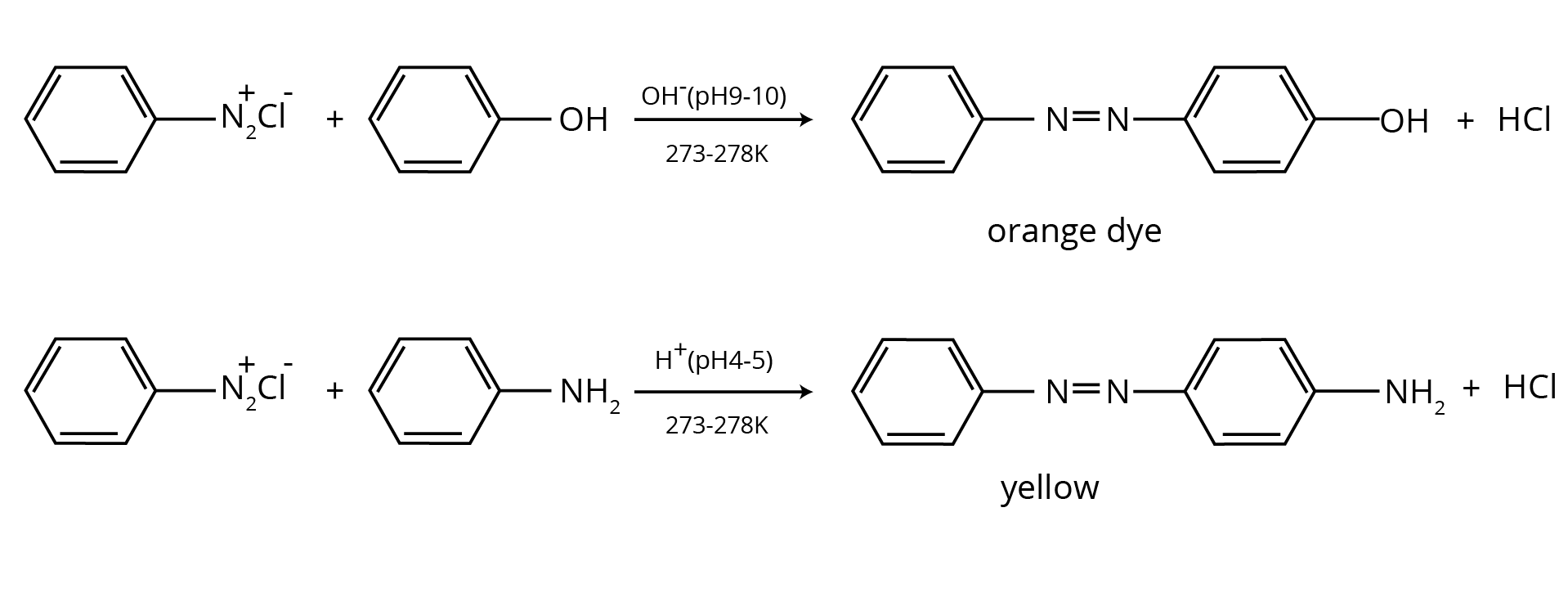
v. Ammonolysis
Ans: It is a process of replacement of either halogen atom in alkyl halides (or aryl halides) or hydroxyl group in alcohols (or phenols) by amino group. The reagent used for ammonolysis is alcoholic ammonia. Generally, a mixture of primary, secondary and tertiary amine is formed.
\[ROH+N{{H}_{3}}\xrightarrow[\text{Hightemp}\text{., Pressure}]{A{{l}_{2}}{{O}_{3}},\Delta }RN{{H}_{2}}+{{H}_{2}}O\]
\[\underset{{{1}^{0}}}{\mathop{R-N{{H}_{2}}}}\,\xrightarrow[-{{H}_{2}}O]{ROH}\underset{{{2}^{0}}}{\mathop{{{R}_{2}}NH}}\,\xrightarrow[-{{H}_{2}}O]{ROH}\underset{{{3}^{0}}}{\mathop{{{R}_{3}}N}}\,\xrightarrow[{}]{ROH}{{R}_{4}}{{N}^{+}}O{{H}^{-}}\]
vi. Acetylation
Ans: The process of introducing an acetyl $(C{{H}_{3}}CO-)$ group into a molecule using acetyl chloride or acetic anhydride is called acetylation.
vii. Gabriel Phthalimide Synthesis
Ans: It is a method of preparation of pure aliphatic and aralkyl primary amines. Phthalimide on treatment with ethanolic KOH gives potassium phthalimide which on heating with a suitable alkyl or aralkyl halides gives N-substituted phthalimides, which on hydrolysis with dil HCl or with alkali give primary amines.
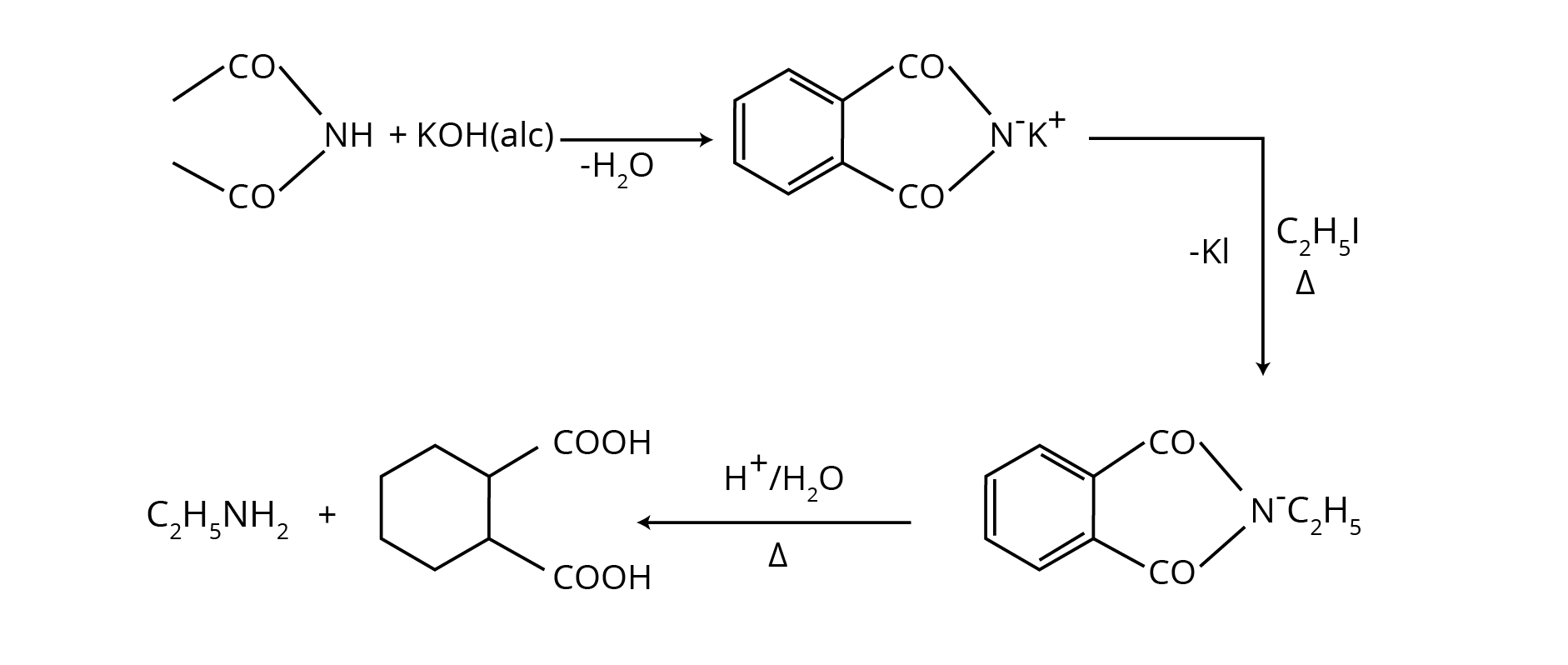
8. Accomplish the following conversations:
i. Nitrobenzene to Benzoic Acid
Ans:

ii. Benzene to M-Bromophenol
Ans:
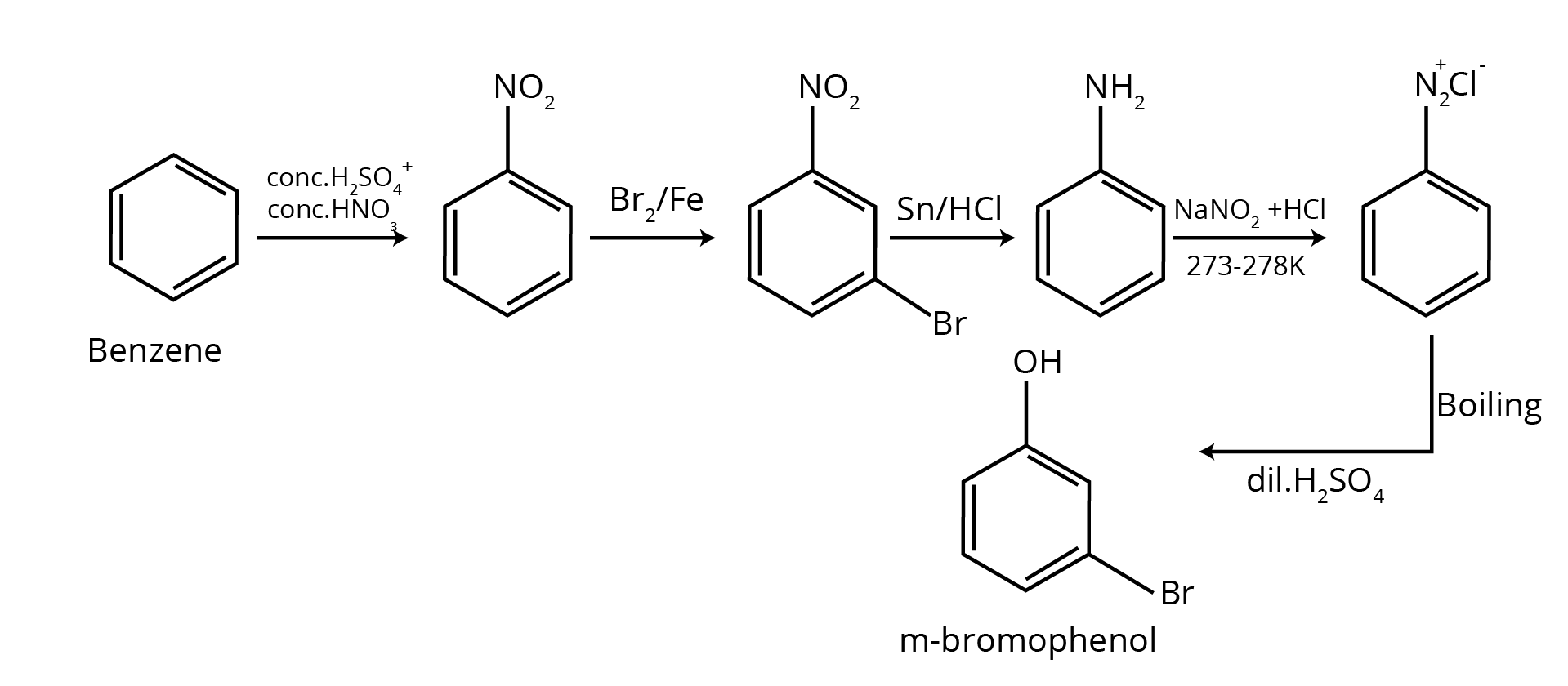
iii. Benzoic Acid to Aniline
Ans:
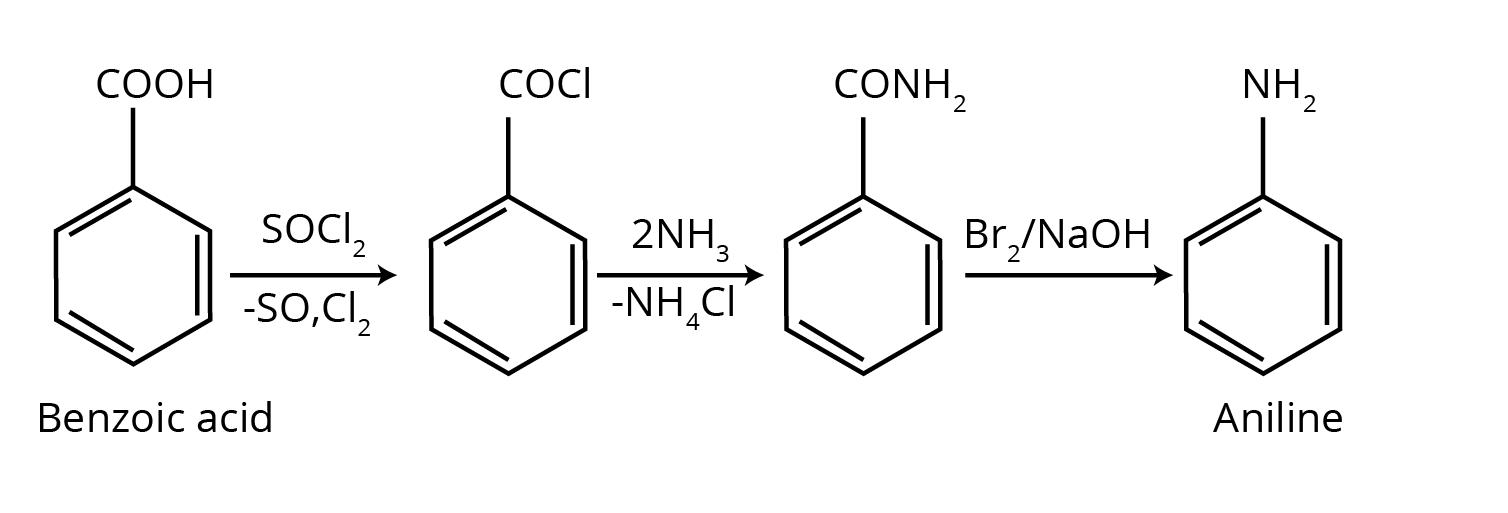
iv. Aniline to 2,4,6-Tribromofluorobenzene
Ans:

v. Benzyl chloride to 2-phenylethanamine
Ans:
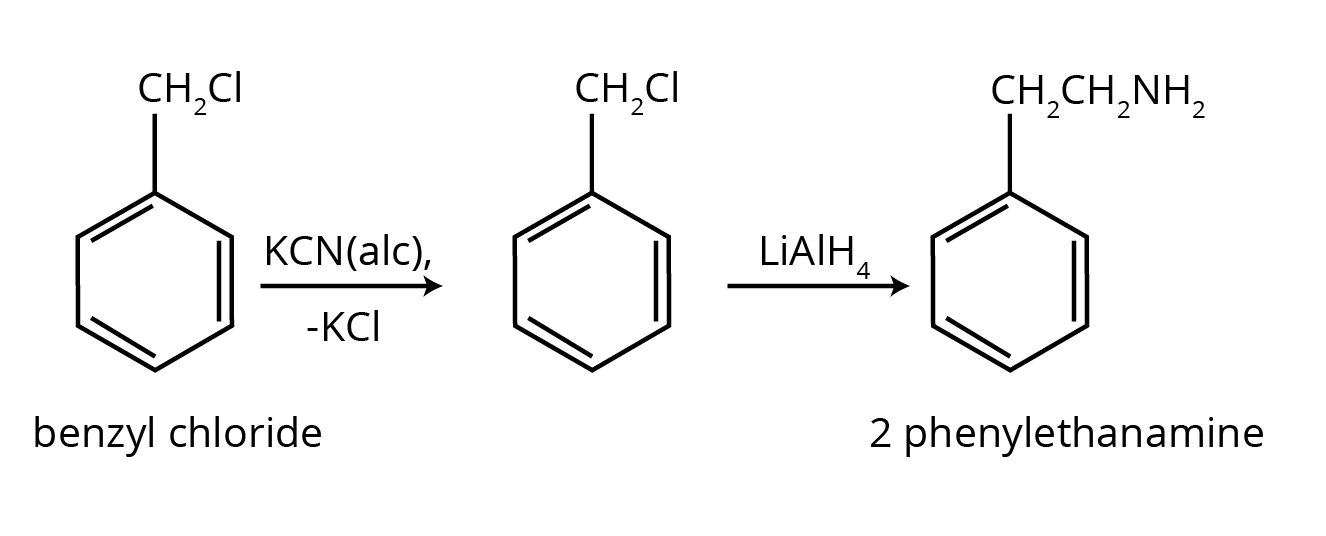
vi. Chlorobenzene to P-Chloroaniline
Ans:
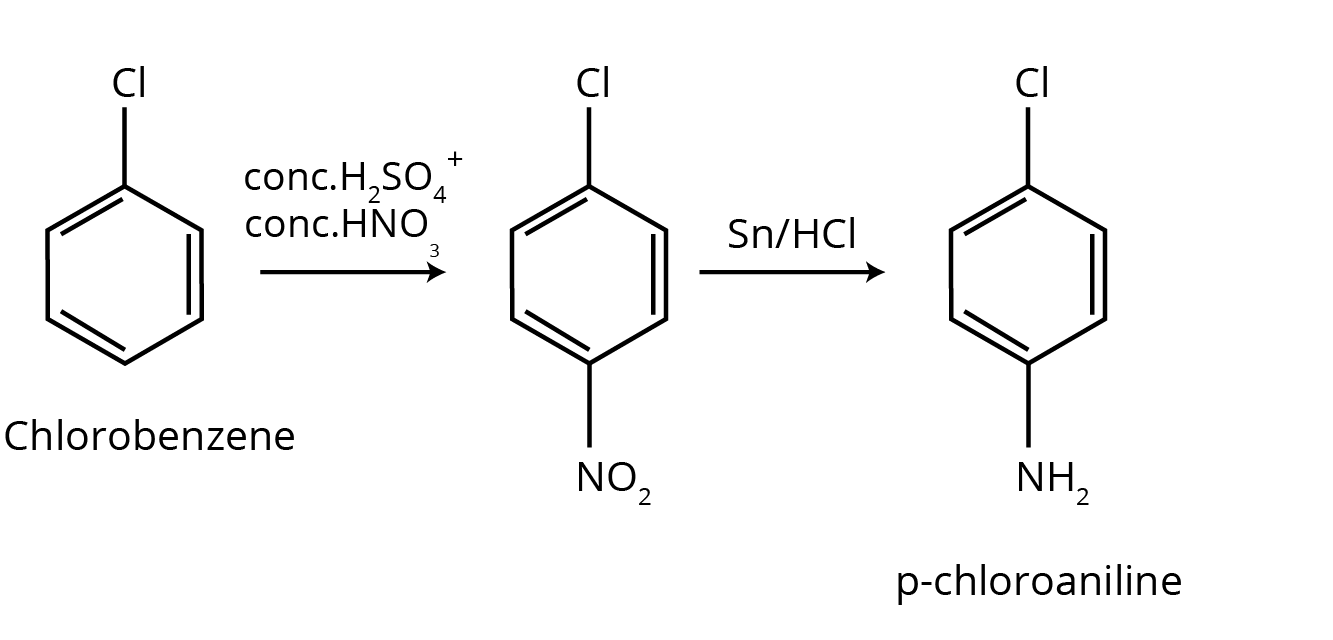
vii. Aniline to p-bromoaniline
Ans:
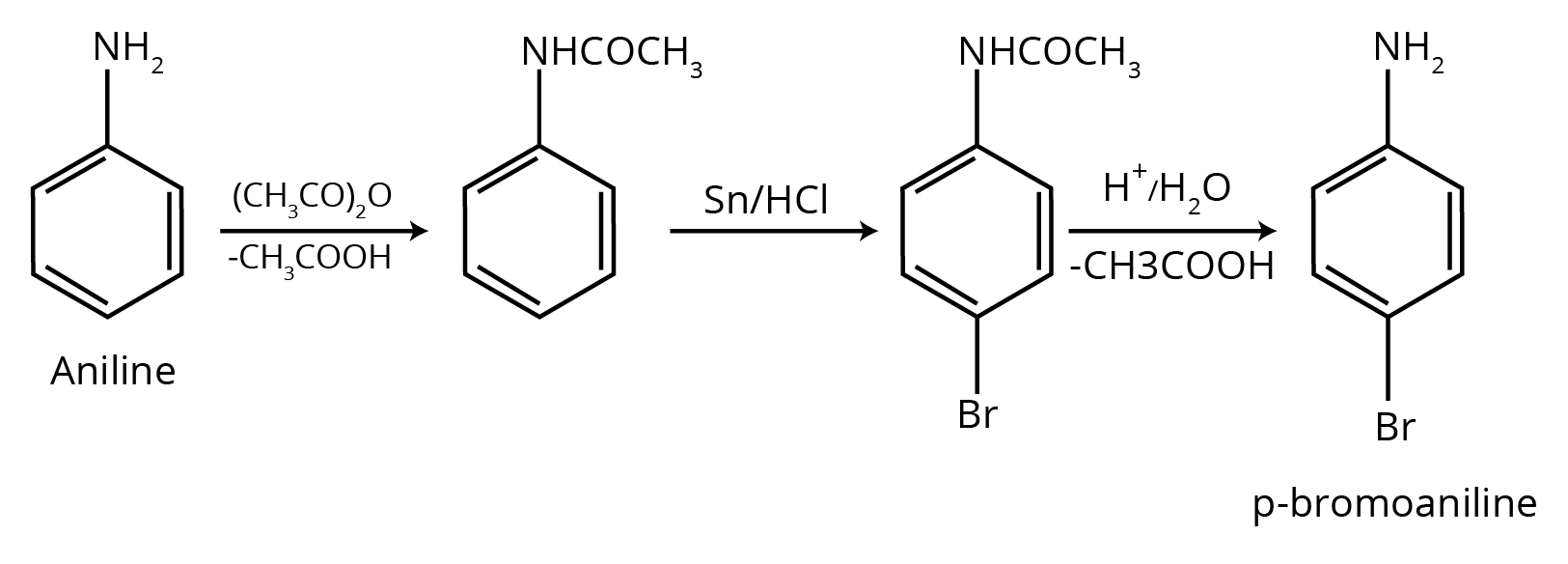
viii. Benzamide to Toluene
Ans:
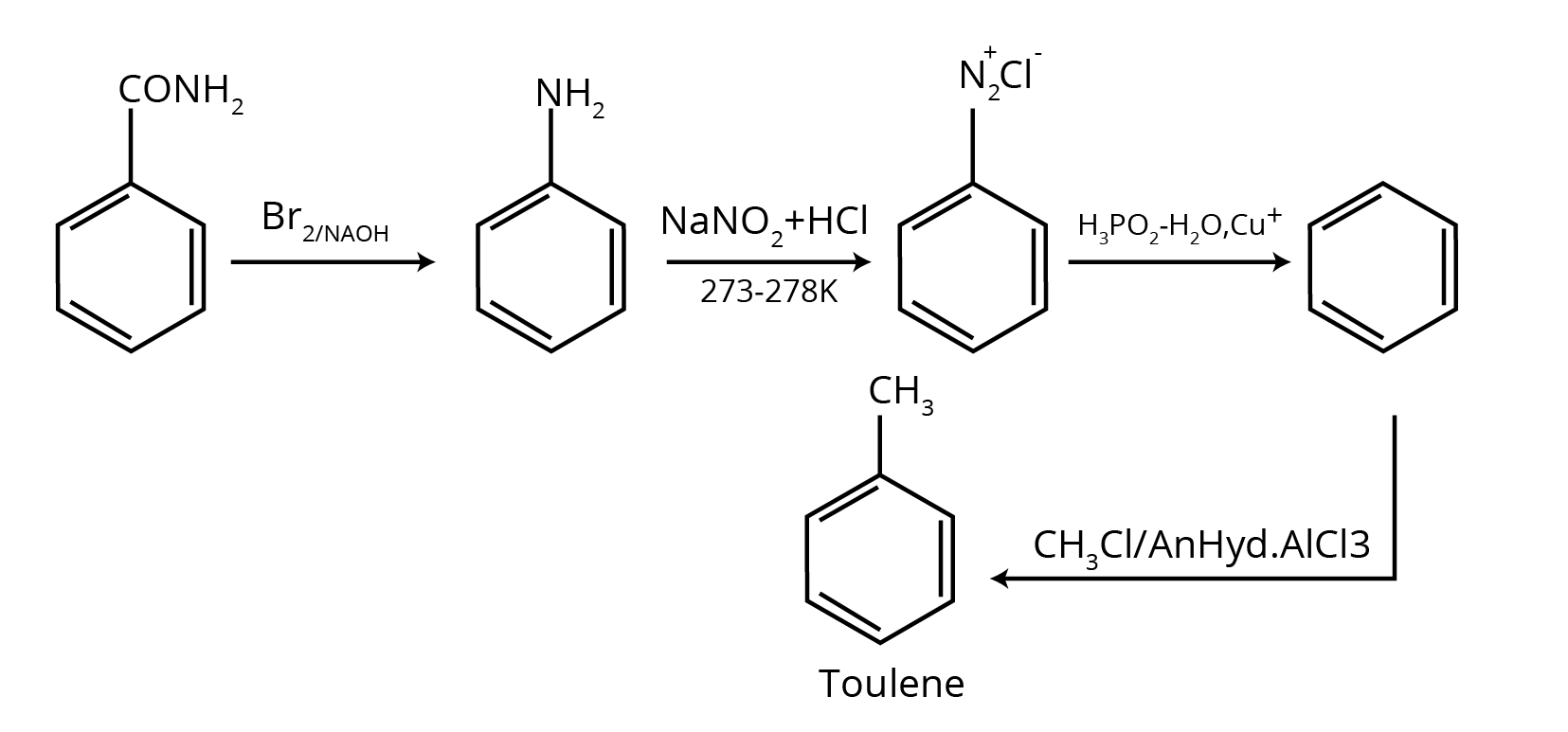
ix. Aniline to Benzyl Alcohol.
Ans:

9. Give the structures of A, B and C in the following reaction:
i. \[C{{H}_{3}}C{{H}_{2}}I\xrightarrow{NaCN}A\xrightarrow[\text{Partial hydrolysis}]{O{{H}^{-}}}B\xrightarrow{NaOH+B{{r}_{2}}}C\]
Ans:
$A=C{{H}_{3}}C{{H}_{2}}CN,B=C{{H}_{3}}C{{H}_{2}}CON{{H}_{2}},C=C{{H}_{3}}C{{H}_{2}}N{{H}_{2}}$
ii. ${{C}_{6}}{{H}_{5}}Cl\xrightarrow{CuCN}A\xrightarrow{{{H}_{2}}O/{{H}^{+}}}B\underset{\Delta }{\mathop{\xrightarrow{N{{H}_{3}}}}}\,C$
Ans:
$A={{C}_{6}}{{H}_{5}}CN,B={{C}_{6}}{{H}_{5}}COOH,C={{C}_{6}}{{H}_{5}}CON{{H}_{2}}$
iii. $C{{H}_{3}}C{{H}_{2}}Br\xrightarrow{KCN}A\xrightarrow{LiAl{{H}_{4}}}B\underset{{{0}^{o}}C}{\mathop{\xrightarrow{HN{{O}_{2}}}}}\,C$
Ans:
$A=C{{H}_{3}}C{{H}_{2}}CN,B=C{{H}_{3}}C{{H}_{2}}C{{H}_{2}}N{{H}_{2}},C=C{{H}_{3}}C{{H}_{2}}C{{H}_{2}}OH$
iv. ${{C}_{6}}{{H}_{5}}N{{O}_{2}}\xrightarrow{Fe/HCl}A\xrightarrow[273K]{NaN{{O}_{2}}+HCl}B\xrightarrow[\Delta ]{{{H}_{2}}O/{{H}^{+}}}C$
Ans:
$A={{C}_{6}}{{H}_{5}}N{{H}_{2}},B={{C}_{6}}{{H}_{5}}{{N}_{2}}C{{l}^{-}},C={{C}_{6}}{{H}_{5}}OH$
v. $C{{H}_{3}}COOH\xrightarrow[\Delta ]{N{{H}_{3}}}A\xrightarrow{NaOBr}B\xrightarrow[HCl]{NaN{{O}_{2}}}C$
Ans: $A=C{{H}_{3}}CON{{H}_{2}},B=C{{H}_{3}}N{{H}_{2}},C=C{{H}_{3}}OH$
vi. ${{C}_{6}}{{H}_{5}}N{{O}_{2}}\xrightarrow{Fe/HCl}A\underset{273K}{\mathop{\xrightarrow{HN{{O}_{2}}}}}\,B\xrightarrow{{{C}_{6}}{{H}_{5}}OH}C$
Ans: $A={{C}_{6}}{{H}_{5}}N{{H}_{2}},B={{C}_{6}}{{H}_{5}}{{N}_{2}}^{+}C{{l}^{-}}$ and C =

10. An aromatic compound ‘A’ on treatment with aqueous ammonia and heating forms compound ‘B’ which on heating with $B{{r}_{2}}$ and KOH forms a compound ‘C. of molecular formula ${{C}_{6}}{{H}_{7}}N$. Write the structures and IUPAC names of compounds A, B and C.
Ans: Since the compound C with molecular formula ${{C}_{6}}{{H}_{7}}N$ is formed from compound B on treatment with $B{{r}_{2}}$ and KOH, therefore, compound ‘B’ must be an amide and ‘C’ must be an amine. The only amine having the molecular formula ${{C}_{6}}{{H}_{7}}N$, i.e., ${{C}_{6}}{{H}_{5}}N{{H}_{2}}$ is aniline. Since ‘C is aniline, therefore, the amide from which it is formed must be benzamide (${{C}_{6}}{{H}_{5}}CON{{H}_{2}}$). Thus, compound ’B’ is benzamide. Since compound 'B' is formed from a compound with aqueous ammonia and heating, therefore, compound ‘A’ must be benzoic acid.
11. Complete the following reaction:
i. ${{C}_{6}}{{H}_{5}}N{{H}_{2}}+CHC{{l}_{3}}+alcKOH\to $
Ans:
${{C}_{6}}{{H}_{5}}N{{H}_{2}}+CHC{{l}_{3}}+alc.KOH\overset{\Delta }{\mathop{\to }}\,{{C}_{6}}{{H}_{5}}NC+3KCl+3{{H}_{2}}O$
ii. ${{C}_{6}}{{H}_{5}}{{N}_{2}}Cl+{{H}_{3}}P{{O}_{2}}+{{H}_{2}}O\to $
Ans: ${{C}_{6}}{{H}_{5}}{{N}_{2}}Cl+{{H}_{3}}P{{O}_{2}}+{{H}_{2}}O\xrightarrow{C{{u}^{+}}}{{C}_{6}}{{H}_{6}}+{{N}_{2}}+{{H}_{3}}P{{O}_{3}}+HCl$
iii. ${{C}_{6}}{{H}_{5}}N{{H}_{2}}+{{H}_{2}}S{{O}_{4}}(conc)\to $
Ans:
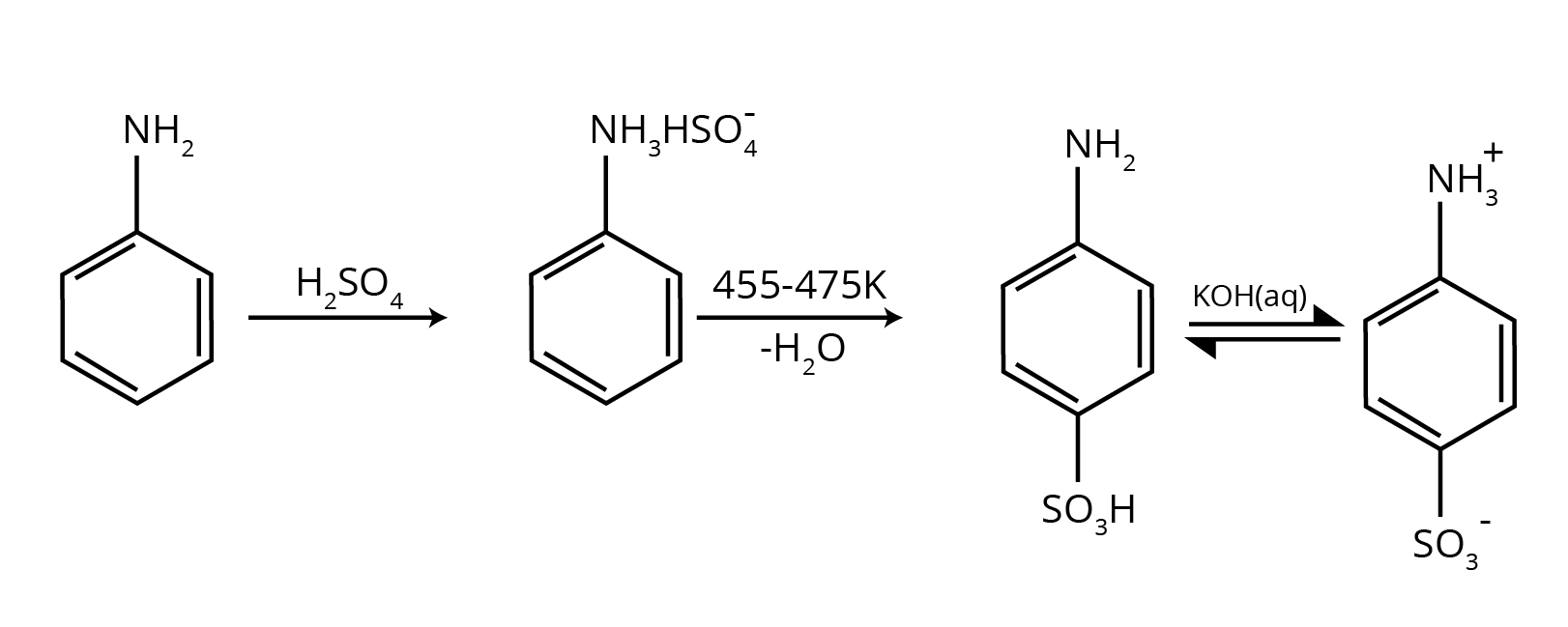
iv. ${{C}_{6}}{{H}_{5}}{{N}_{2}}Cl+{{C}_{2}}{{H}_{5}}OH\to $
Ans:
${{C}_{6}}{{H}_{5}}{{N}_{2}}Cl+{{C}_{2}}{{H}_{5}}OH\to {{C}_{6}}{{H}_{6}}+C{{H}_{3}}CHO+{{N}_{2}}+HCl$
v. ${{C}_{6}}{{H}_{5}}N{{H}_{2}}+B{{r}_{2}}(aq)\to $
Ans:
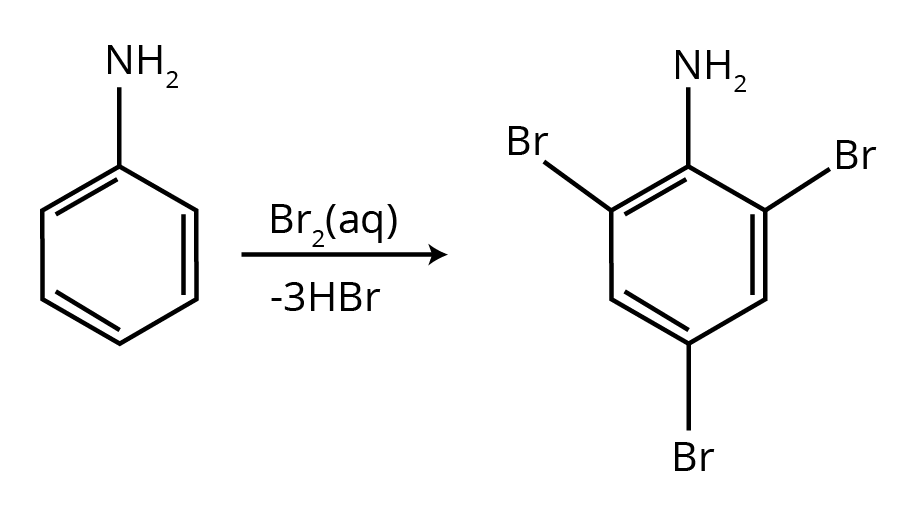
vi. ${{C}_{6}}{{H}_{5}}N{{H}_{2}}+{{(C{{H}_{3}}CO)}_{2}}O\to $
Ans: ${{C}_{6}}{{H}_{5}}N{{H}_{2}}+{{(C{{H}_{3}}CO)}_{2}}O\xrightarrow{C{{H}_{3}}COOH}{{C}_{6}}{{H}_{5}}NHCOC{{H}_{3}}+C{{H}_{3}}COOH$
vii. ${{C}_{6}}{{H}_{5}}{{N}_{2}}Cl\xrightarrow[(ii)NaN{{O}_{2}}/Cu.\Delta ]{(i)HB{{F}_{4}}}$
Ans:
${{C}_{6}}{{H}_{5}}{{N}_{2}}Cl\xrightarrow[(ii)NaN{{O}_{2}}/Cu.\Delta ]{(i)HB{{F}_{4}}}{{C}_{6}}{{H}_{5}}N{{O}_{2}}+{{N}_{2}}+NaB{{F}_{4}}$
12. Why cannot aromatic primary amines be prepared by Gabriel phthalimide synthesis?
Ans: The success of Gabriel phthalimide reaction depends upon the nucleophilic attack by the phthalimide anion on the organic halogen compound. Since aryl halides do not undergo nucleophilic substitution reactions easily, therefore, arylamines, i.e. aromatic, primary amines cannot be prepared by Gabriel phthalimide reaction.
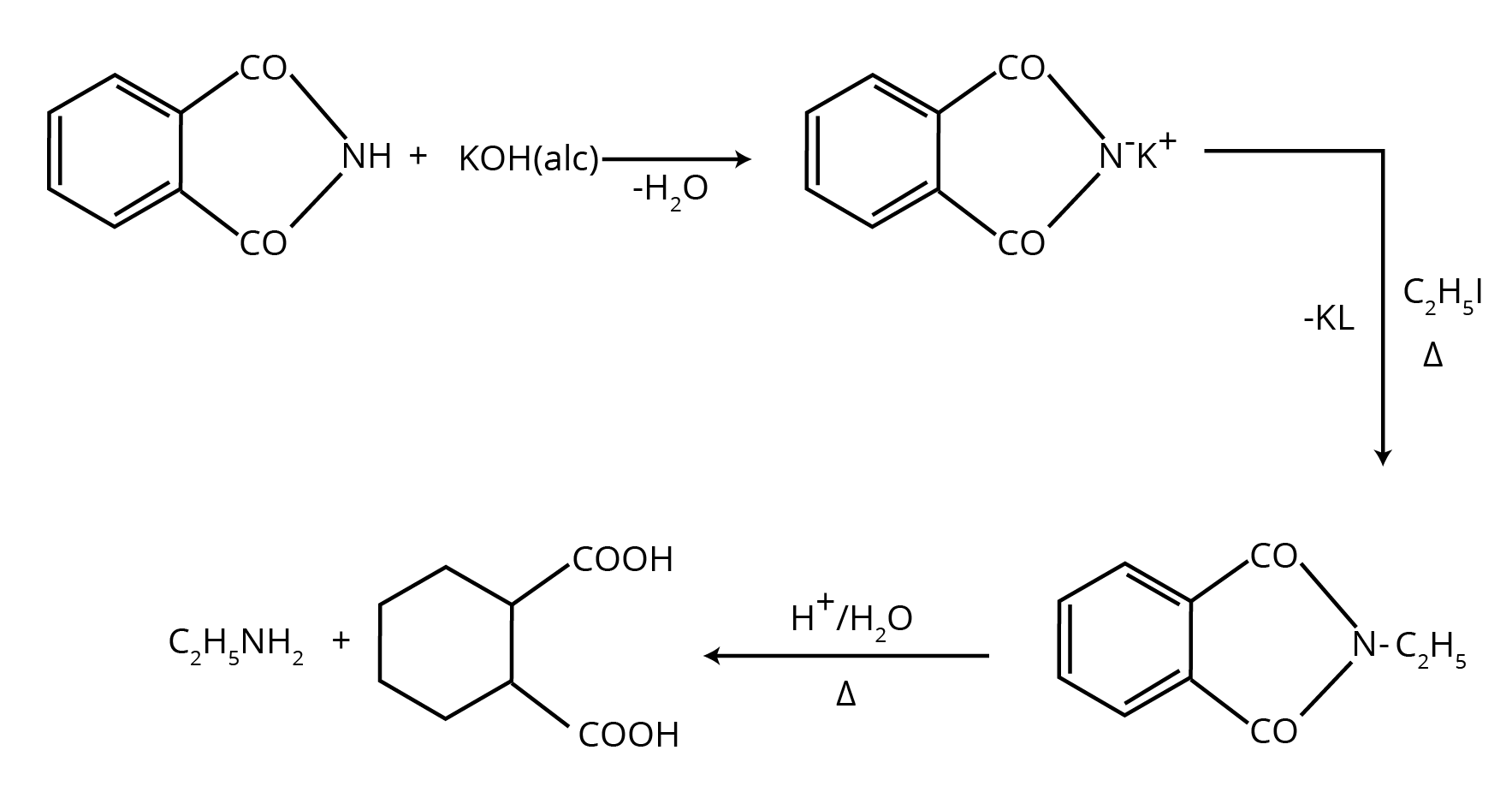

13. Write the reactions of aromatic and aliphatic primary amines with nitrous acid.
Ans: Both aromatic and aliphatic primary amines react with $HN{{O}_{2}}$ at 273-278 K to form aromatic and aliphatic diazonium salts respectively. But aliphatic diazonium salts are unstable even at this low temperature and thus decompose readily to form a mixture of compounds. Aromatic and aliphatic primary amines react with $HN{{O}_{2}}$ as follows
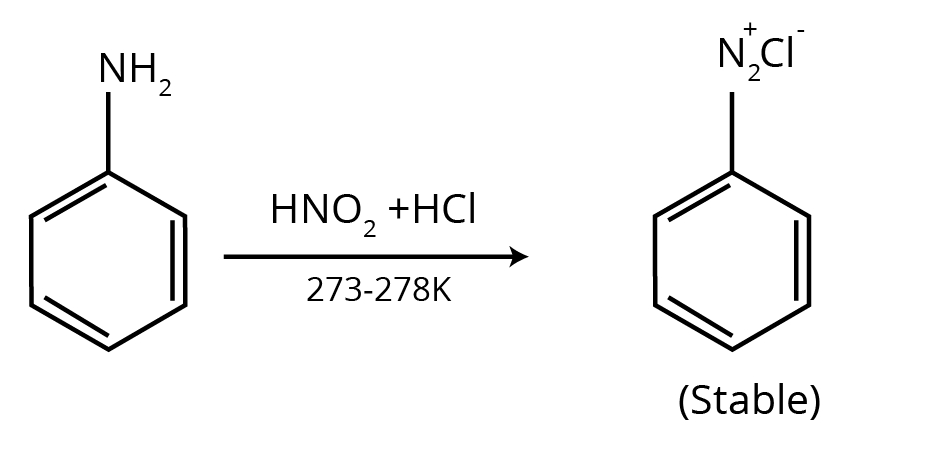
\[C{{H}_{3}}C{{H}_{2}}N{{H}_{2}}+HONO+HCl\xrightarrow[-{{H}_{2}}O]{273-278K}[C{{H}_{3}}C{{H}_{2}}-{{N}^{+}}_{2}C{{l}^{-}}]\xrightarrow[273-278K]{\text{Decomposes}}C{{H}_{3}}C{{H}_{2}}OH+C{{H}_{2}}=C{{H}_{2}}+C{{H}_{3}}C{{H}_{2}}Cl+{{N}_{2}}\]
14. Give plausible explanation for each of the following:
i. Why are amines less acidic than alcohols of comparable molecular masses?
Ans: Loss of proton from an amine gives an amide ion while loss of a proton from alcohol gives an alkoxide ion.
\[R-N{{H}_{2}}\to R-N{{H}^{-}}+{{H}^{+}}\]
\[R-O-H\to R-{{O}^{-}}+{{H}^{+}}\]
Since O is more electronegative than N, it will attract positive species more strongly in comparison to N. Thus, RO is more stable than$RN{{H}^{-}}$ . Thus, alcohols are more acidic than amines. Conversely, amines are less acidic than alcohols.
ii. Why do primary amines have higher boiling point than tertiary amines?
Ans: Since O is more electronegative than N, it will attract positive species more strongly in comparison to N. Thus, RO is more stable than RNH-. Thus, alcohols are more acidic than amines. Conversely, amines are less acidic than alcohols.
iii. Why aliphatic amines stronger bases than aromatic amines?
Ans: Aromatic amines are far less basic than ammonia and aliphatic amines because of following reasons:
(a) Due to resonance in aniline and other aromatic amines, the lone pair of electrons on the nitrogen atom gets delocalized over the benzene ring and thus it is less easily available for protonation. Therefore, aromatic amines are weaker bases than ammonia and aliphatic amines.
(b) Aromatic amines are more stable than corresponding protonated ion; Hence, they have very less tendency to combine with a proton to form corresponding protonated ion, and thus they are less basic.
Class 12 Chemistry Chapter 9 Quick Overview of Topics
Chemistry class 12 chapter 9 NCERT Solutions - Quick Overview of Detailed Structure of Topics and Subtopics Covered.
Topics | Subtopics |
Introduction to Amines | Definition and classification of amines |
Nomenclature of amines | |
Preparation of Amines | Methods: Reduction of nitro compounds, Gabriel phthalimide synthesis, Hoffmann bromamide reaction, Reduction of amides |
Physical Properties of Amines | Odour, solubility, boiling point, and basicity |
Chemical Reactions of Amines | Alkylation, acylation, and carbylamine reactions |
Reaction with Nitrous Acid: Diazotization reaction | |
Reaction with HNO₂: Formation of nitrosamines | |
Reaction with Haloalkanes: Nucleophilic substitution | |
Preparation of Diazonium Salts | Methods: Diazotization reaction |
Importance and Applications | Synthetic dyes, pharmaceuticals, and rubber industry |
Some Important Concepts of Class 12 Chapter 9 Amines
Class 12 NCERT solutions help the students to go through the Concepts easily. Find the important topics in Chapter 9 - Amines to crack your exams.
Classification of Amines: Amines are classified based on the number of alkyl or aryl groups attached to the nitrogen atom. They can be primary (one alkyl/aryl group), secondary (two alkyl/aryl groups), or tertiary (three alkyl/aryl groups) amines.
Preparation Methods: Amines can be prepared by various methods including:
Reduction of nitro compounds
Reduction of nitriles
Gabriel synthesis
Hoffmann bromamide reaction
Ammonolysis of alkyl halides
Basicity of Amines: Amines are basic due to the presence of a lone pair of electrons on the nitrogen atom. The basicity of amines increases with the availability of lone pairs, which is influenced by the number of alkyl or aryl groups attached to the nitrogen atom.
Hoffmann Bromamide Reaction: This reaction is used to synthesise primary amines from a primary amide. The primary amide is treated with bromine and a base to form an isocyanate intermediate, which is then hydrolysed to yield the primary amine.
Aromatic Amines: Aromatic amines are derivatives of benzene in which one or more hydrogen atoms are replaced by amino groups (-NH2). Aniline is the simplest aromatic amine and an important precursor in synthesising dyes, pharmaceuticals, and other organic compounds.
Benefits of Referring to Vedantu’s NCERT Solutions for Class 12 Chemistry Amines
The Vedantu’s class 12 NCERT Solutions of Chemistry provided here in PDFs offer various benefits, including:
Detailed explanations and step-by-step solutions for all topics in Amines.
Solutions curated by experienced educators to ensure accuracy and clarity.
It covers important concepts like amines, which are classified based on the number of alkyl or aryl groups attached to the nitrogen atom.
Clear and concise explanations using precise chemical terminology.
In-depth analysis of key concepts and their applications in real-life scenarios.
A detailed explanation of important reactions such as Classification of Amines: They can be primary (one alkyl/aryl group), secondary (two alkyl/aryl groups), or tertiary (three alkyl/aryl groups) amines.
Solutions to a variety of problems to strengthen analytical and problem-solving abilities.
Step-by-step solutions for numerical problems and reaction mechanisms.
Study Materials Links for Class 12 Chemistry Chapter 9 NCERT Solutions
Students can access extra study materials on Amines. These resources are available for download and offer additional support for your studies.
S.No | Related Links for Class 12 Chemistry Chapter 9: Amines |
1. | |
2. | |
3. |
Conclusion
Amines NCERT Solutions class 12 covers a wide range of questions, answers and explanations that help students learn and revise this chapter. The topics and sub-topics covered in this chapter provide a thorough knowledge base of amines' structure, types, and basicity. Also, the preparation and several other important aspects of Amines are explained in detail in the NCERT Solutions for this Chapter on Vedantu. Students are suggested to download and prepare all the relevant study resources on NCERT Amines Solutions from Vedantu to ace their exams.
NCERT Solutions Class 12 Chemistry | Chapter-wise Links
Access Vedantu’s chapter-wise NCERT Chemistry Class 12 Solutions PDFs below for all other chapters.
S.No. | NCERT Solutions Class 12 Chemistry Chapter-wise List |
1 | |
2 | |
3 | |
4 | |
5 | |
6 | |
7 | |
8 | Chapter 8 - Aldehydes, Ketones and Carboxylic Acids Solutions |
9 |
NCERT Solutions Class 12 Chemistry - Related Links
S.No | Important Resources Links for Class 12 Chemistry |
1 | |
2 | |
3 | |
4 | |
5 |
FAQs on NCERT Solutions for Class 12 Chemistry Chapter 9 Amines
1. What are the Three Categories of Amines?
Amines can be classified into primary, secondary, and tertiary depending on the number of hydrogen atoms replaced from ammonia by organic groups when a single hydrogen atom is replaced, a primary amine is formed.
When two or three hydrogen atoms are replaced, secondary and tertiary amines are formed, respectively. Students who will appear for their boards can expect multiple questions on this classification. Therefore, students should have a clear understanding of it.
Moreover, they can take the help of NCERT Solutions for class 12 Chemistry chapter 13 PDF to get a comprehensive knowledge of this topic. The elaborate explanation, along with the diagrams, will help them to understand it in a hassle-free way.
2. How Should I Study Amines for my Boards?
Amines are a crucial topic for boards and other competitive exams. Moreover, while preparing for this, students should focus on the categories of amines. They should also learn the IUPAC names of the various compounds. Apart from this, conversion and reactions have a significant share in this chapter. They should have an understanding of the chemical properties of Amines. However, studying all these topics without proper guidance may be difficult. Therefore, students can opt for class 12 Amines NCERT solutions PDF, which will help them to develop a clear understanding of these topics.
3. Why Should I Refer to the Class 12 Amines NCERT Solutions PDF?
Amine is a topic that demands conceptual clarity. To score well, students must have comprehensive knowledge about every subtopic. However, doing this without proper guidance may be difficult. In this case, students can opt for Amines NCERT Solutions class 12 PDF download. They can easily access these Solutions anywhere. All the questions are explained elaborately. Multiple diagrams are also used for better understanding, and the language used in these Amines solutions is straightforward.
Moreover, it will help them to study a topic at their convenience. Also, these Solutions can be downloaded free of cost. After completing the exercises on their own, students can refer to the Solutions to verify their answers.
4. How can I access the FREE PDF download of NCERT Solutions for Class 12 Chemistry Chapter 9 on Vedantu?
You can access the free PDF download of Amines NCERT Solutions class 12 on Vedantu's website. Simply visit the website, locate the chapter, and click on the download link to get the solutions in PDF format.
5. Are the class 12 chemistry Amines NCERT solutions accurate and reliable?
Yes, the Amines NCERT Solutions class 12 provided by Vedantu are prepared by experienced subject experts. They are accurate and reliable, and they follow the guidelines and syllabus provided by NCERT. Students can rely on these solutions for their exam preparation.
6. Can Amines NCERT Solutions class 12 help me score better in exams?
Yes, class 12 chemistry Amines NCERT solutions are designed to help you understand the concepts thoroughly. By practising the solutions and solving the questions, you can improve your understanding and problem-solving skills, which can ultimately help you score better in your exams.
7. What do amines react with?
Amines, as discussed in NCERT solutions for class 12 chemistry, undergo reactions elucidated in the amines exercise solutions, providing comprehensive understanding,
8. What are the uses of amines?
The uses of amines, elucidated in class 12 amines NCERT solutions, span across pharmaceuticals, dyes, rubber chemicals, and solvents, offering practical applications.
9. What are the physical properties of amines?
Physical properties of amines, outlined in amines NCERT solutions class 12, include strong odour, water solubility, and boiling points correlating with molecular weight, providing detailed insights.
10. What are the biological uses of amines?
Biological uses of amines, as detailed in NCERT Amine class 12, encompass neurotransmission, hormone/vitamin synthesis, and antibacterial properties, highlighting their significance.
11. What are the factors affecting the basicity of amines?
Factors affecting the basicity of amines, discussed in class 12 chemistry amines NCERT solutions, involve substituents' electron-donating or withdrawing nature and steric hindrance around the nitrogen atom, emphasising their impact.
12. Why are amines used in drugs?
Amines' utility in drugs, expounded in Amine class 12 NCERT solutions pdf, stems from their salt-forming ability with acids, facilitating water solubility, and interactions with biological macromolecules, crucial for pharmaceutical efficacy.






















